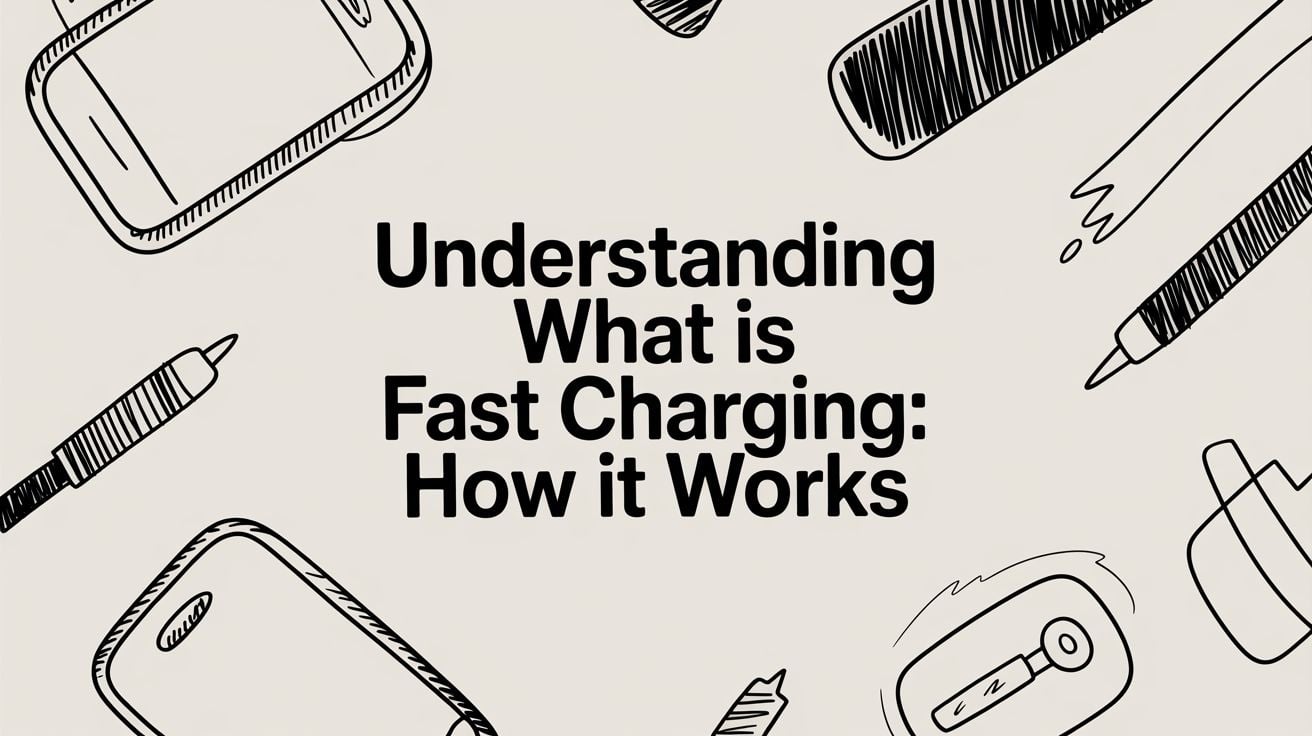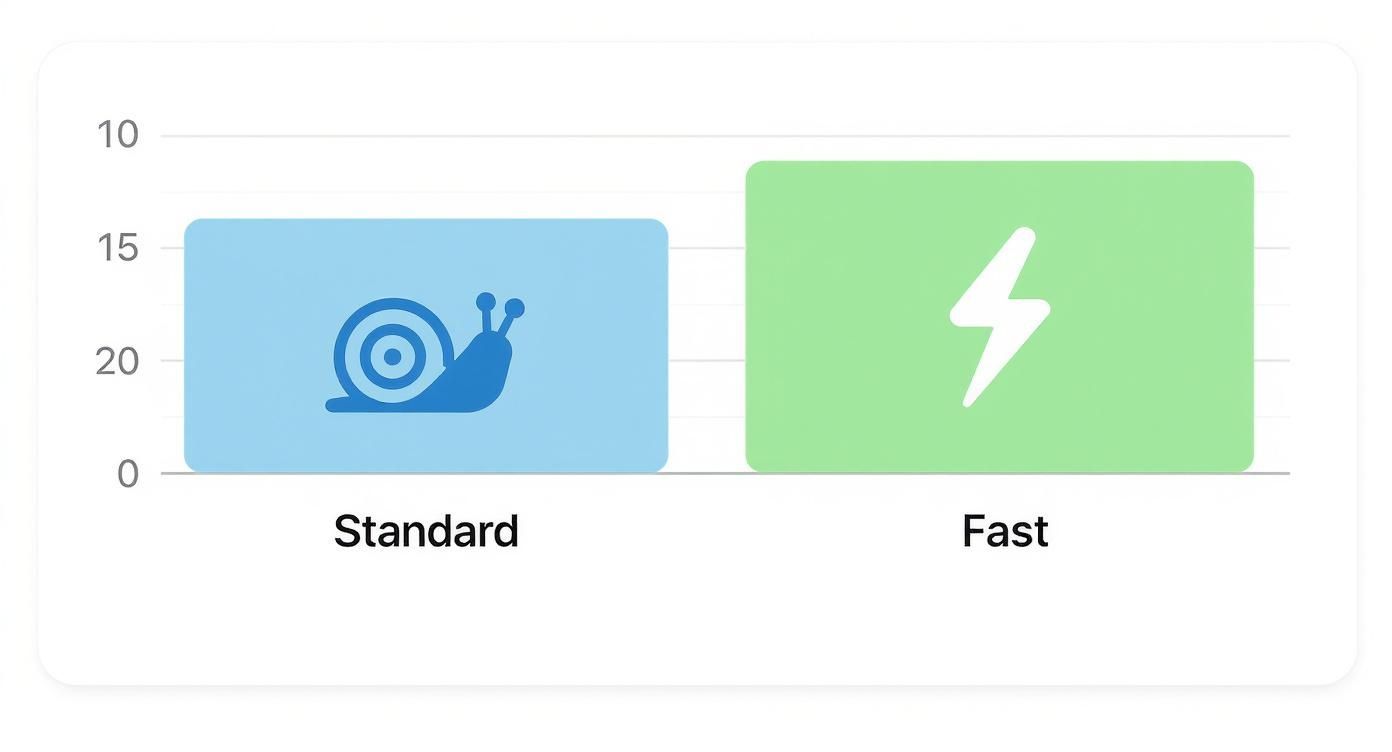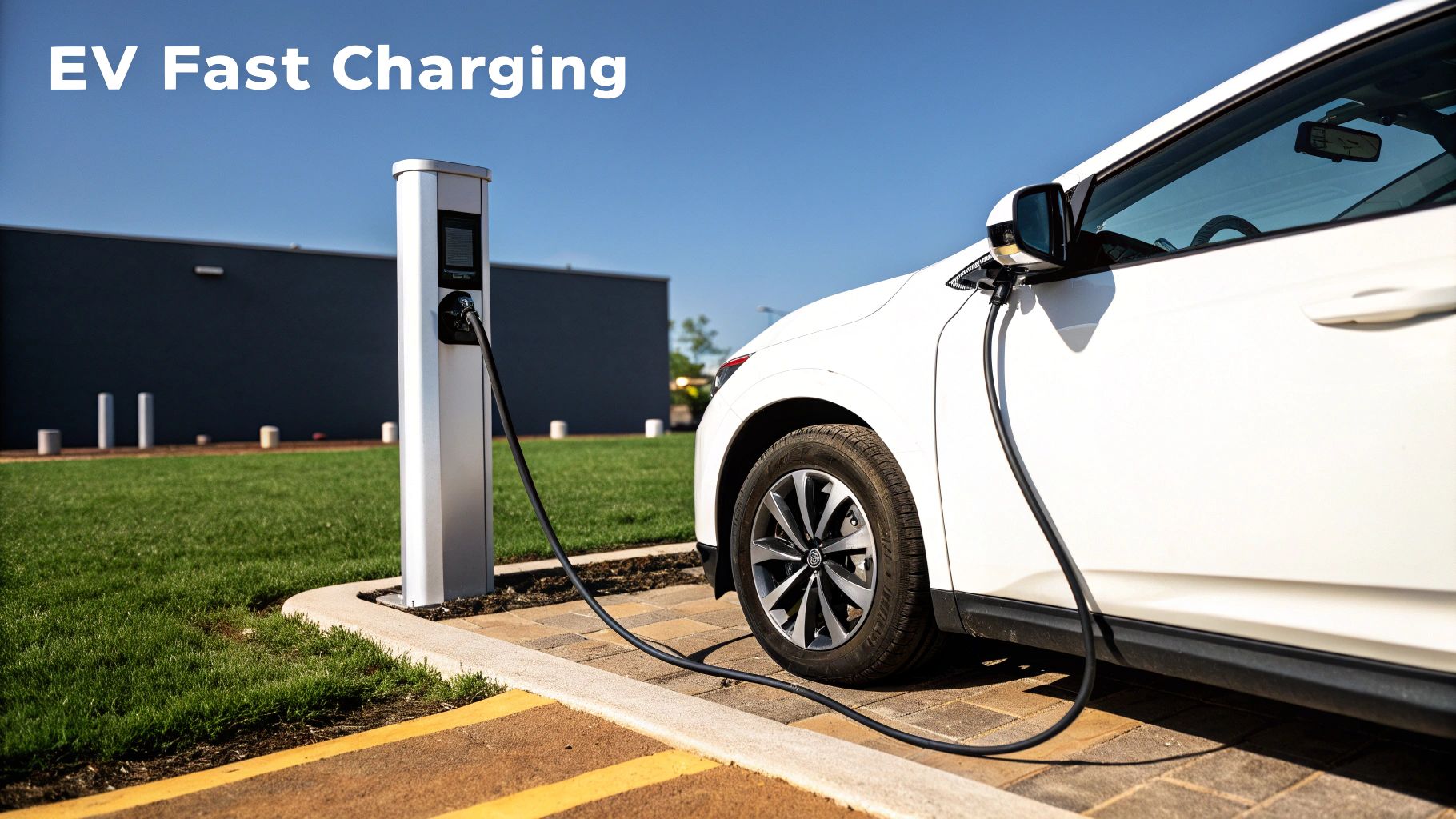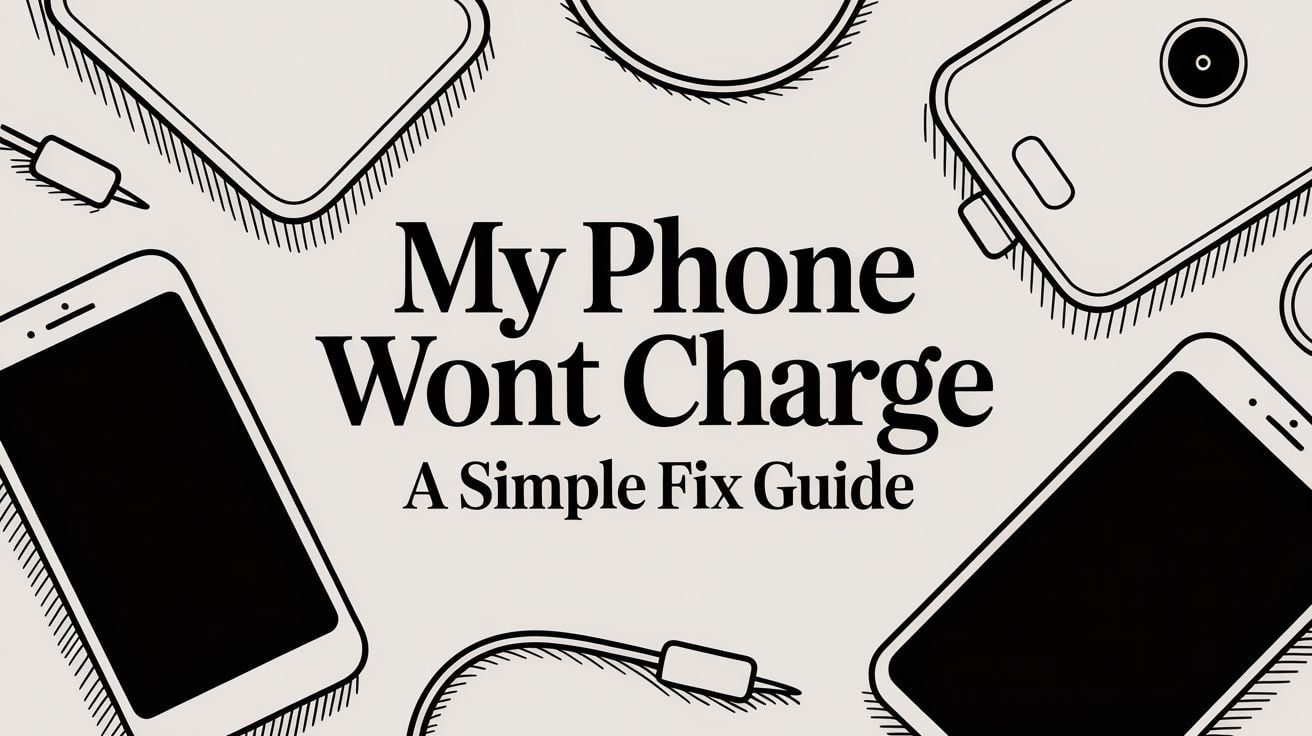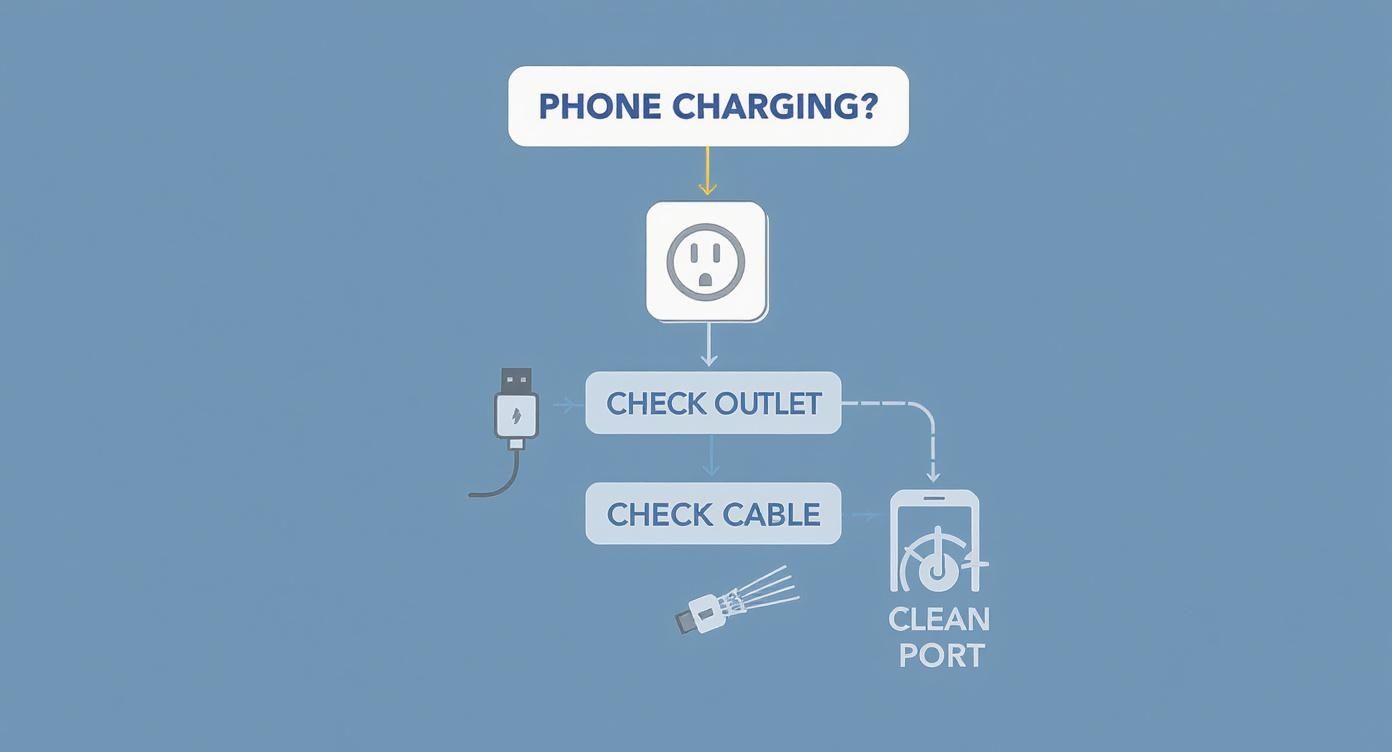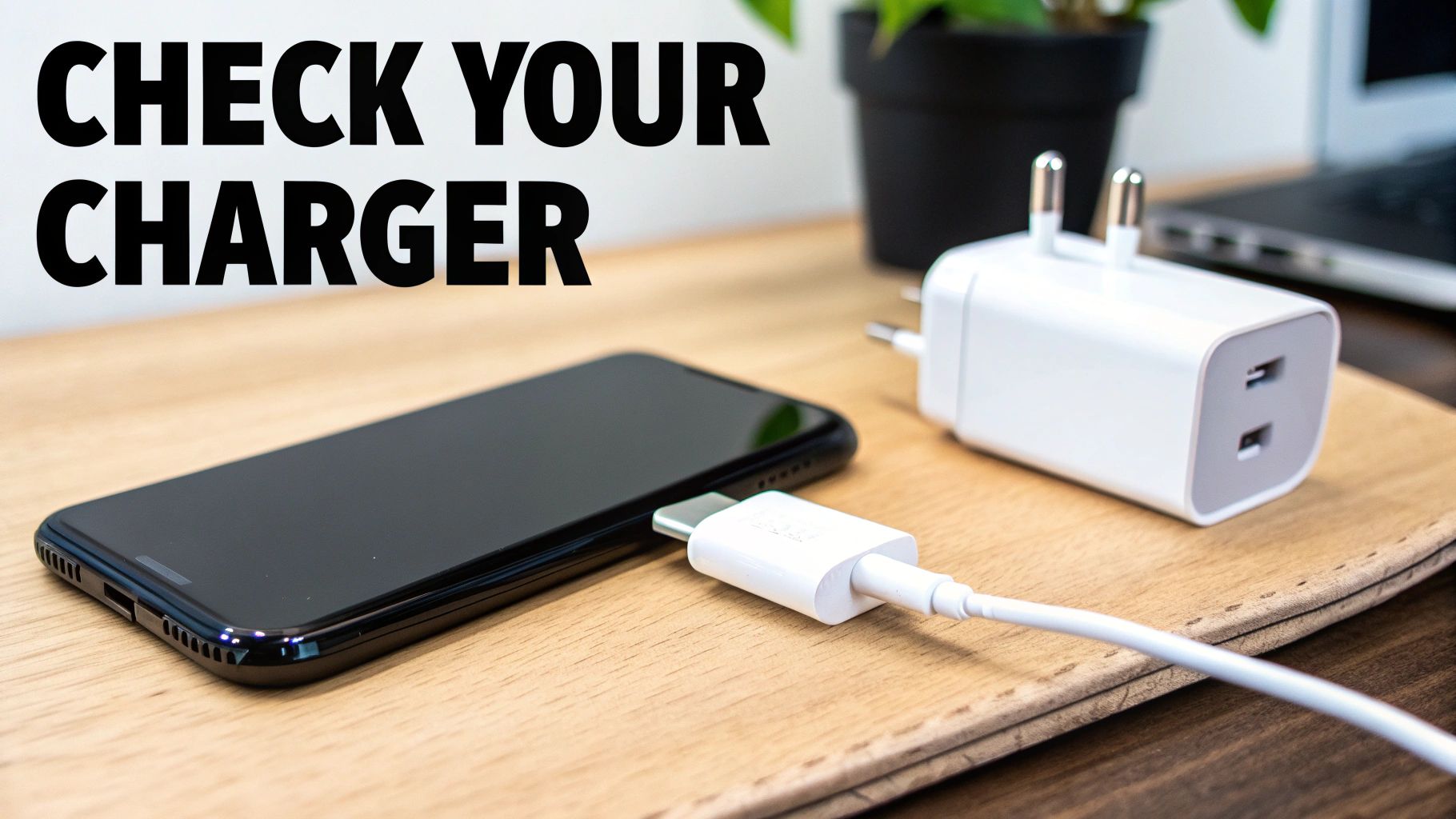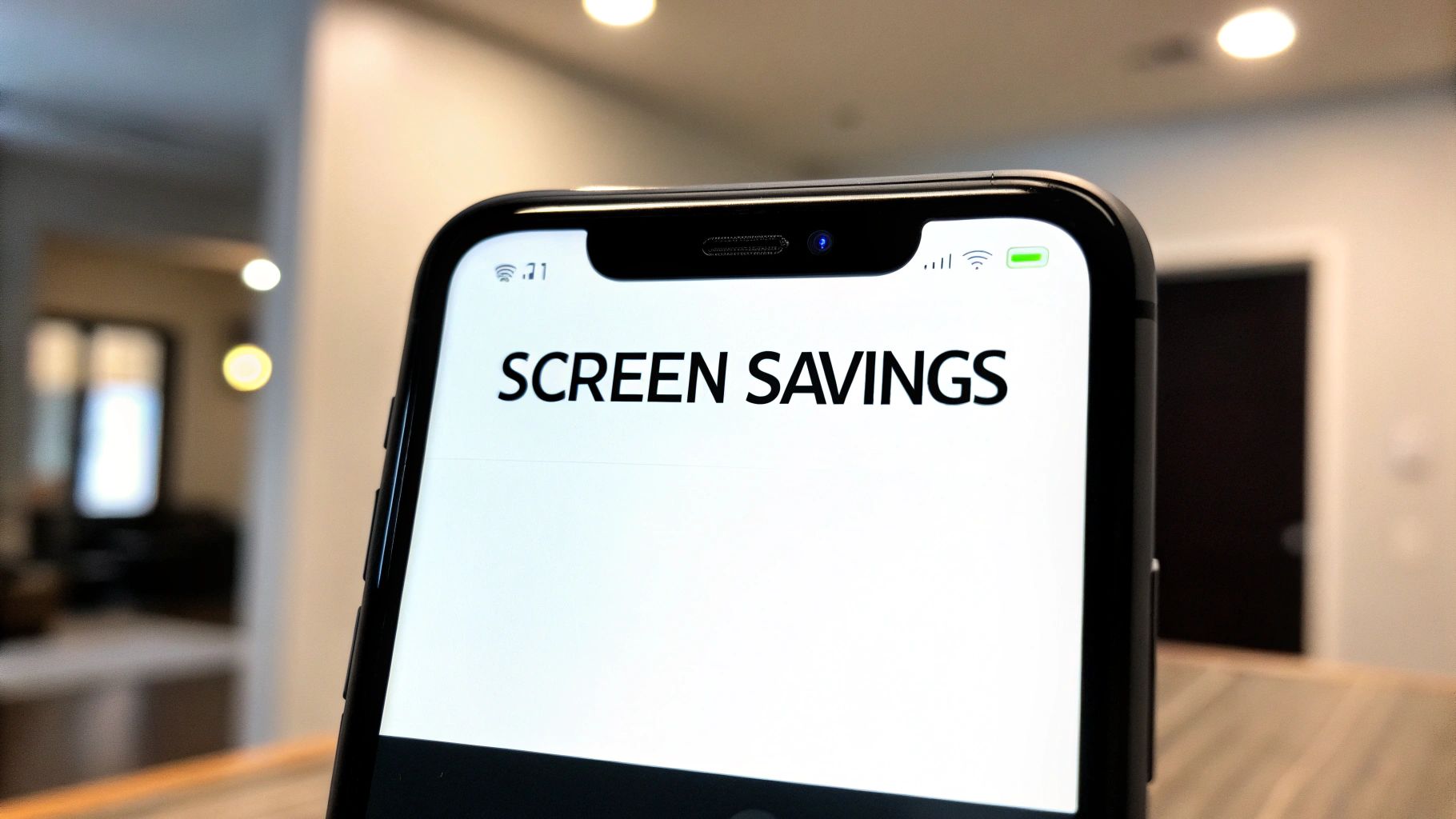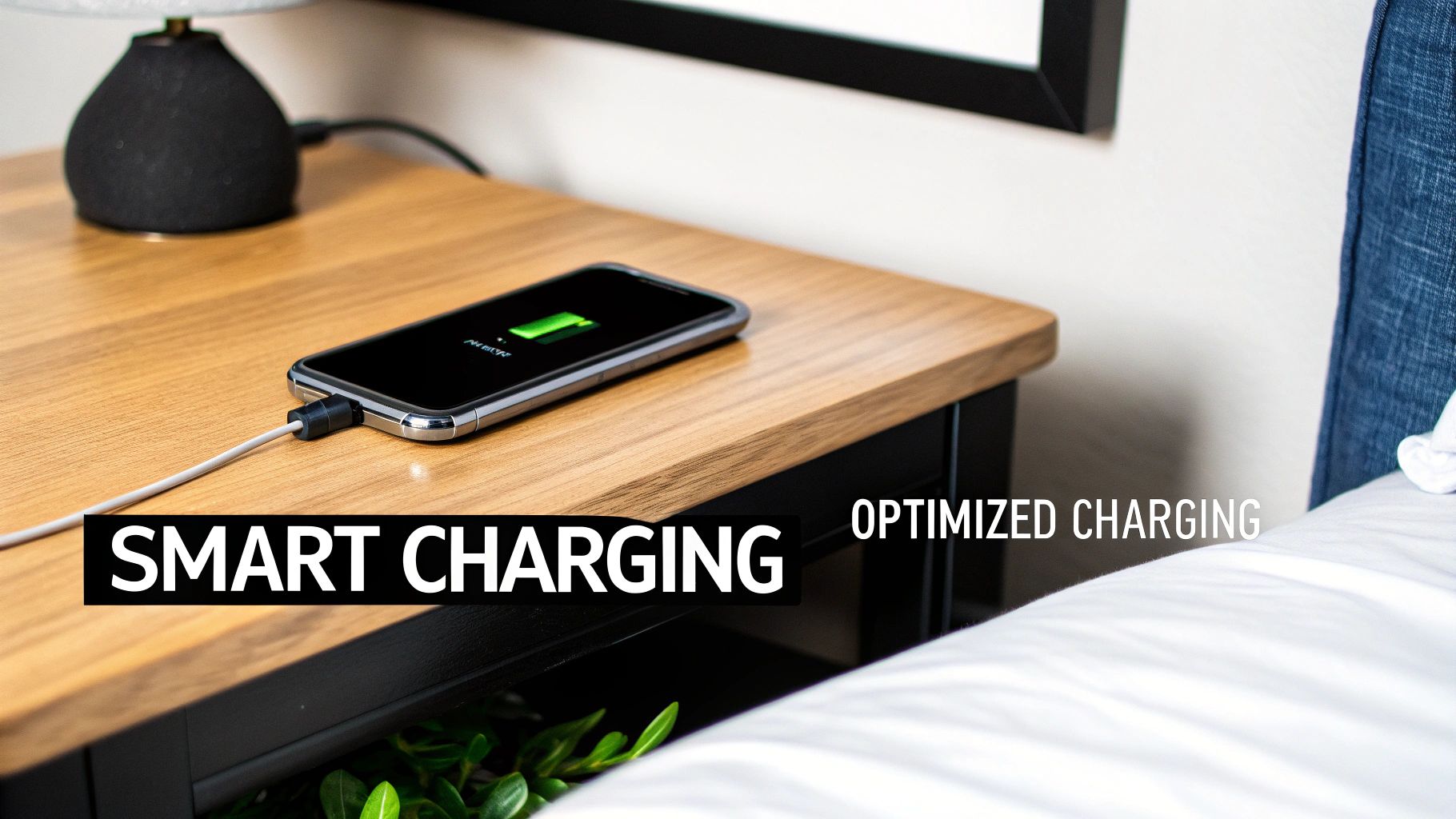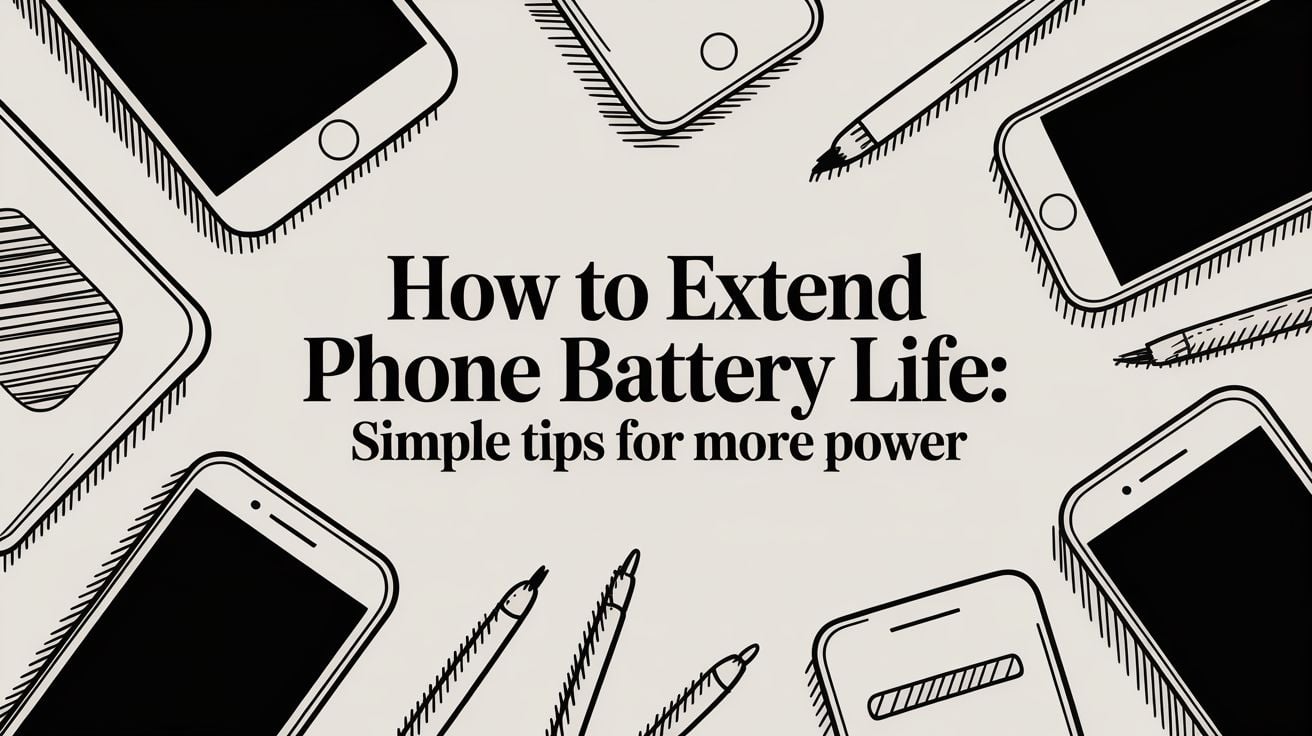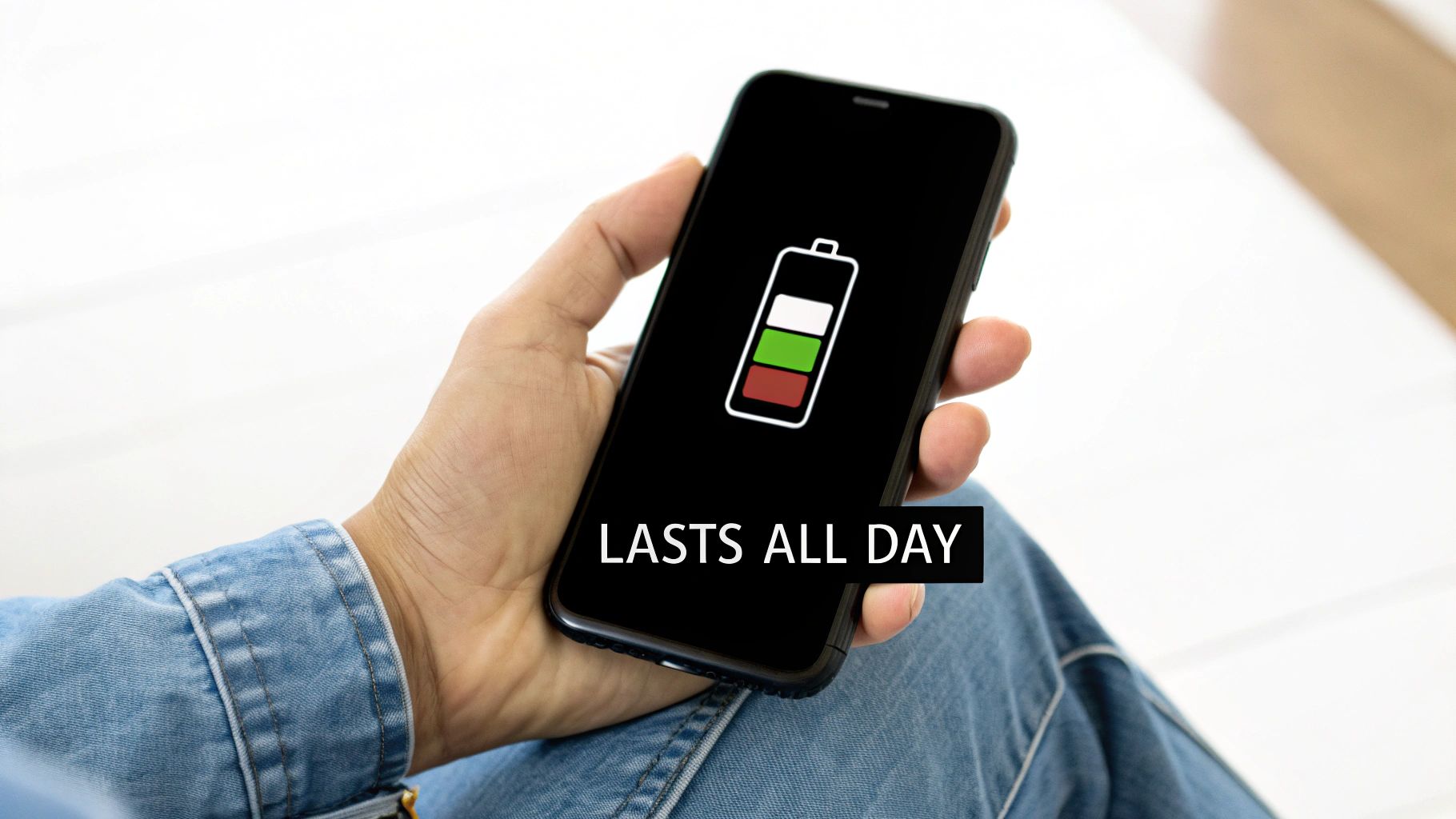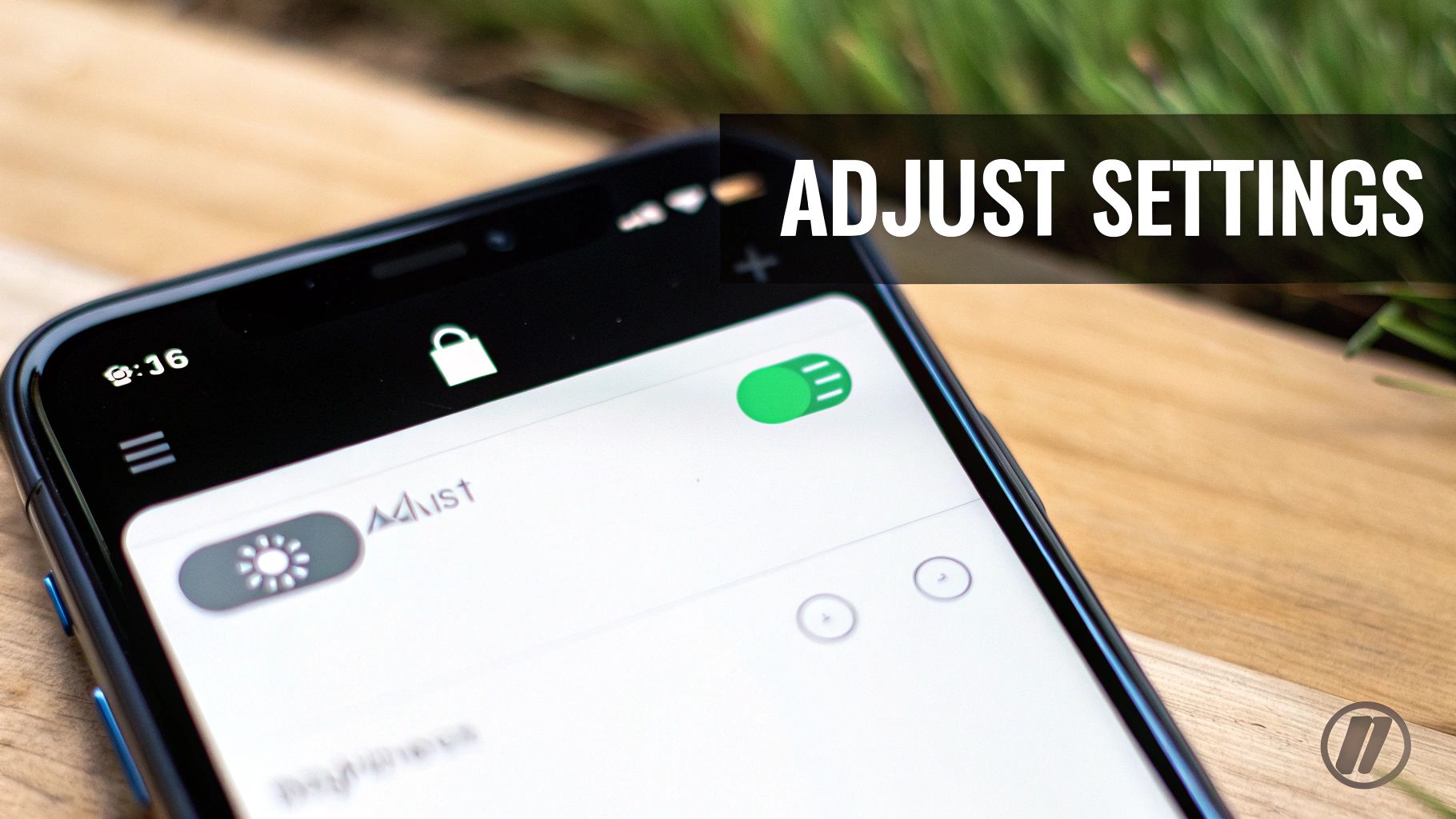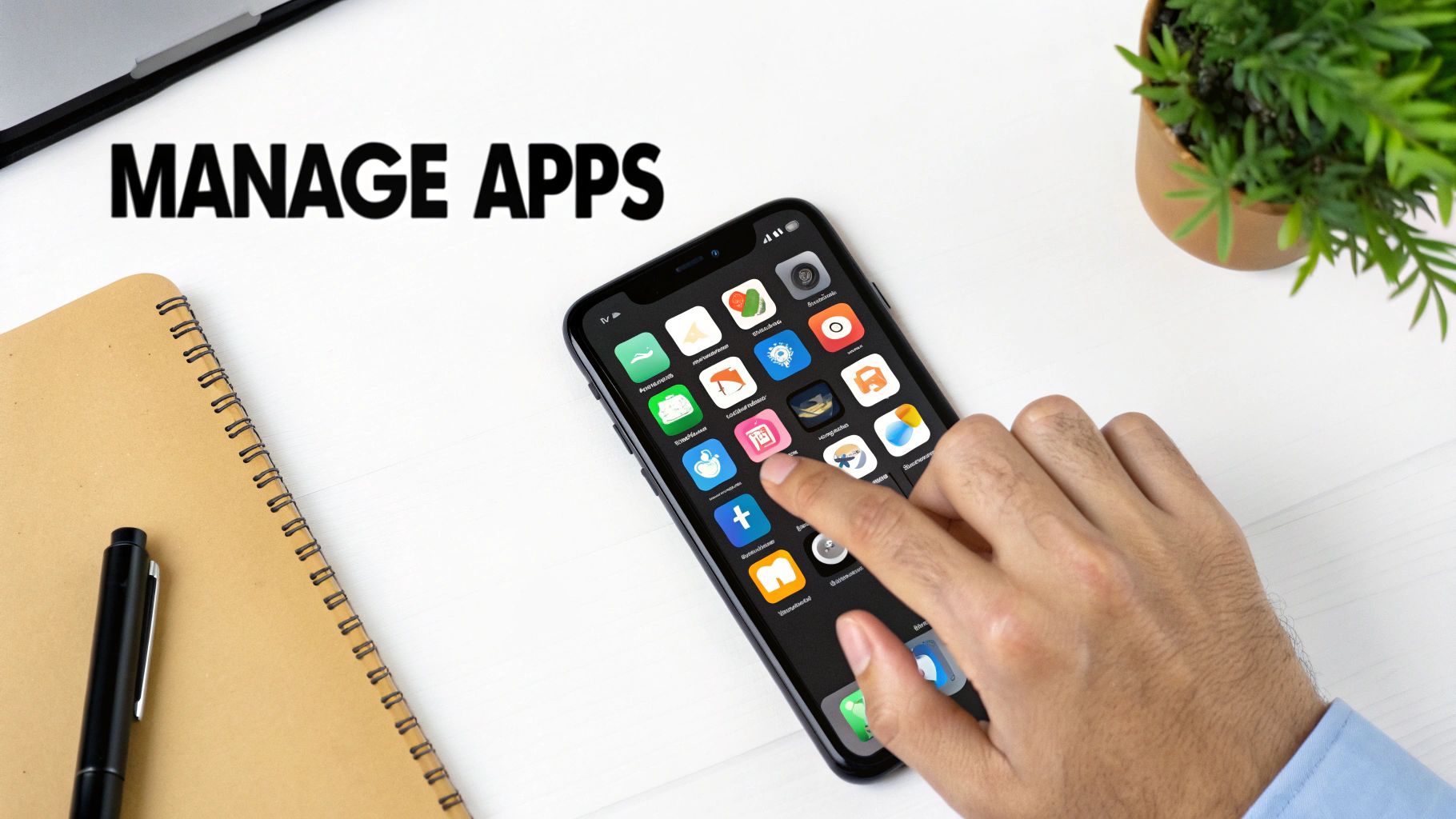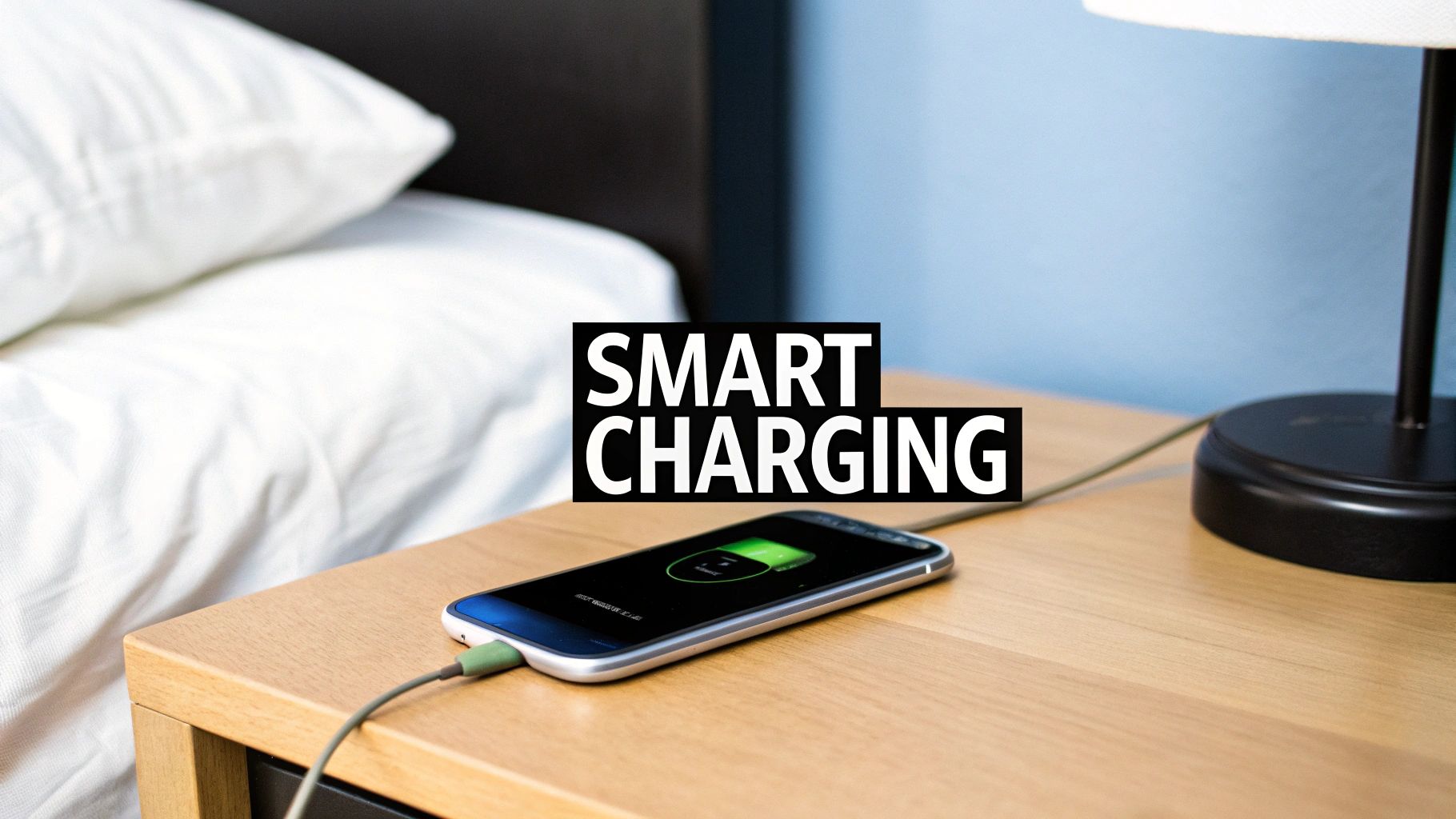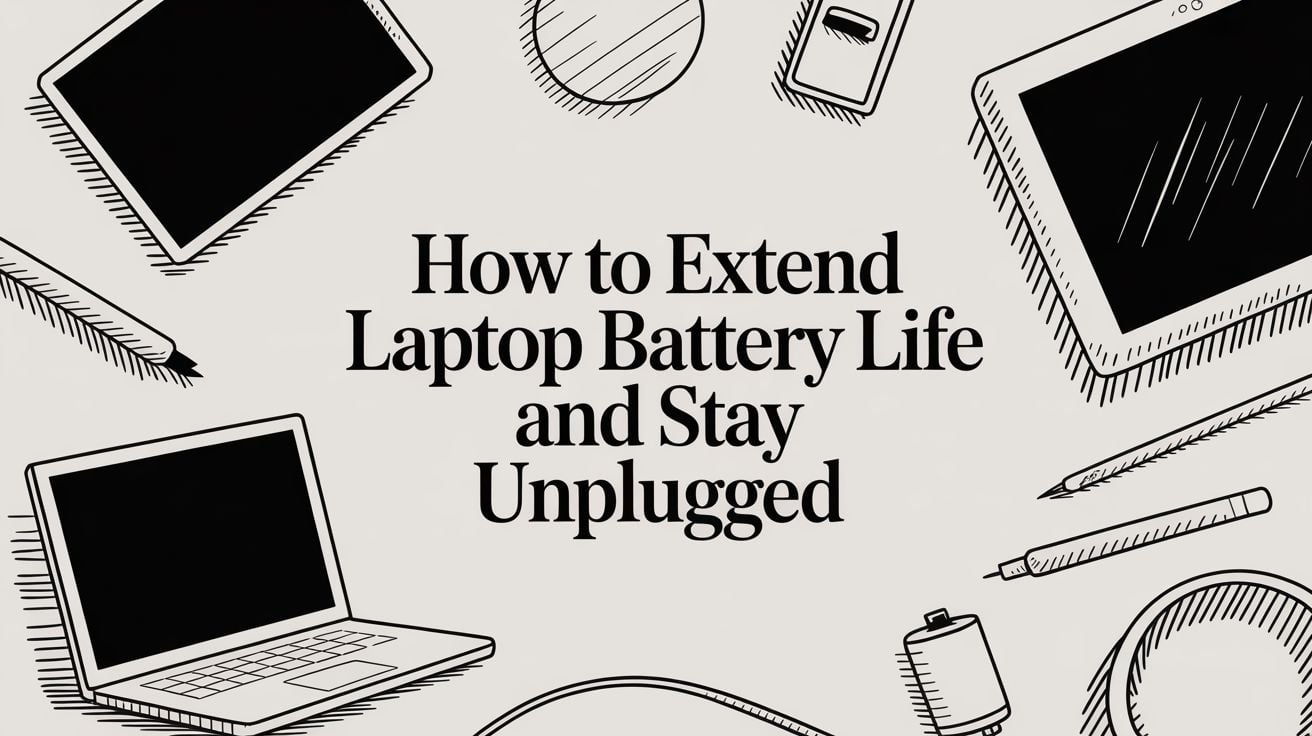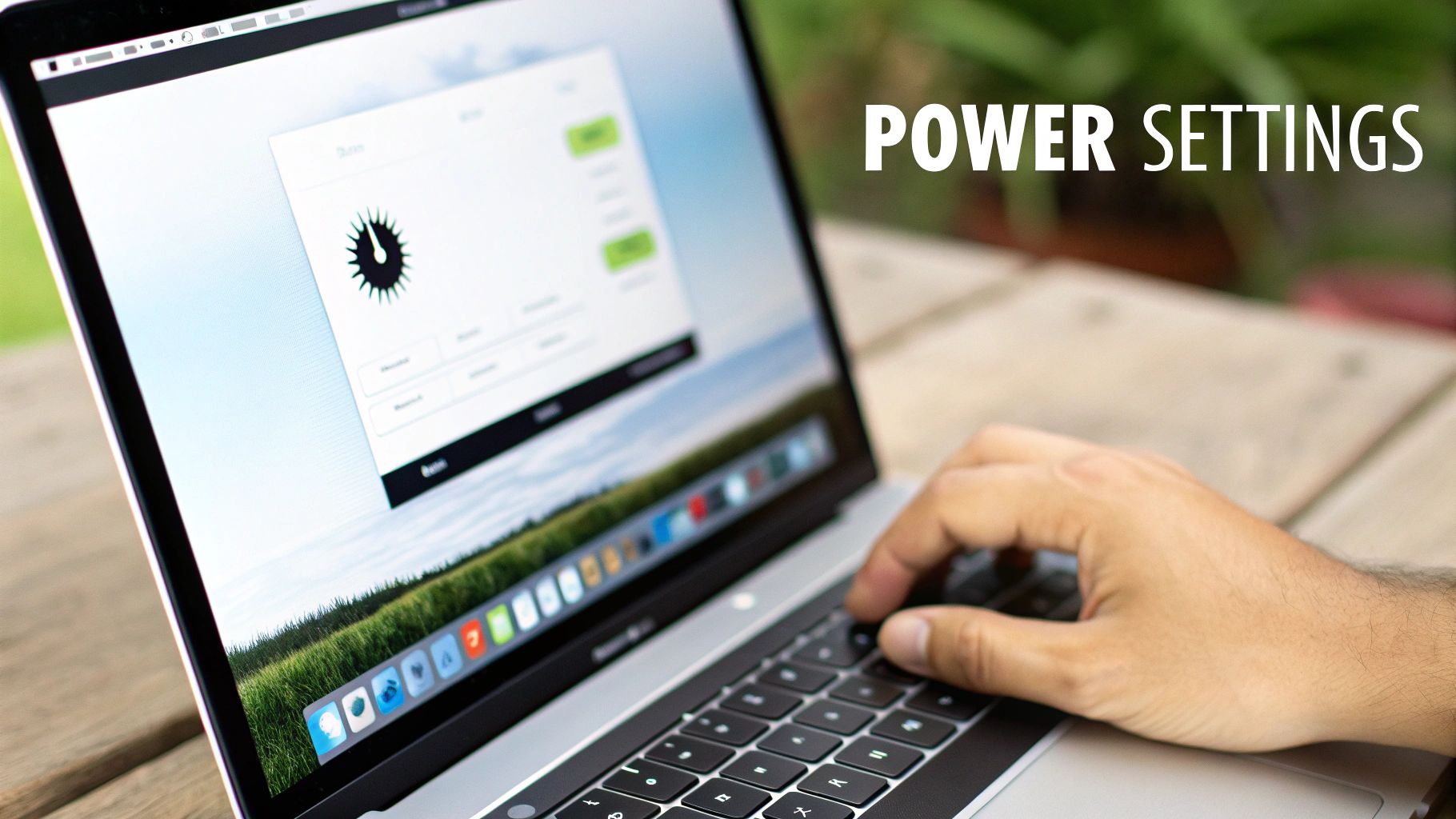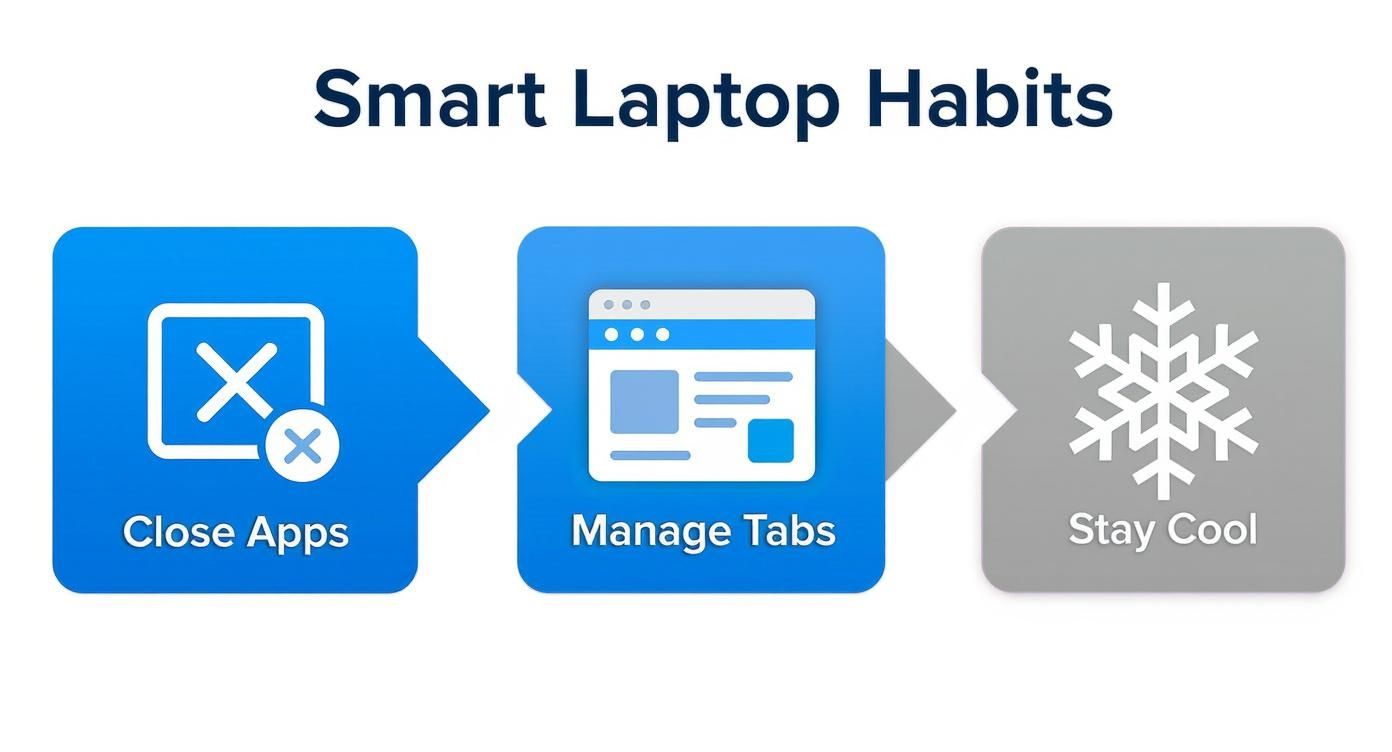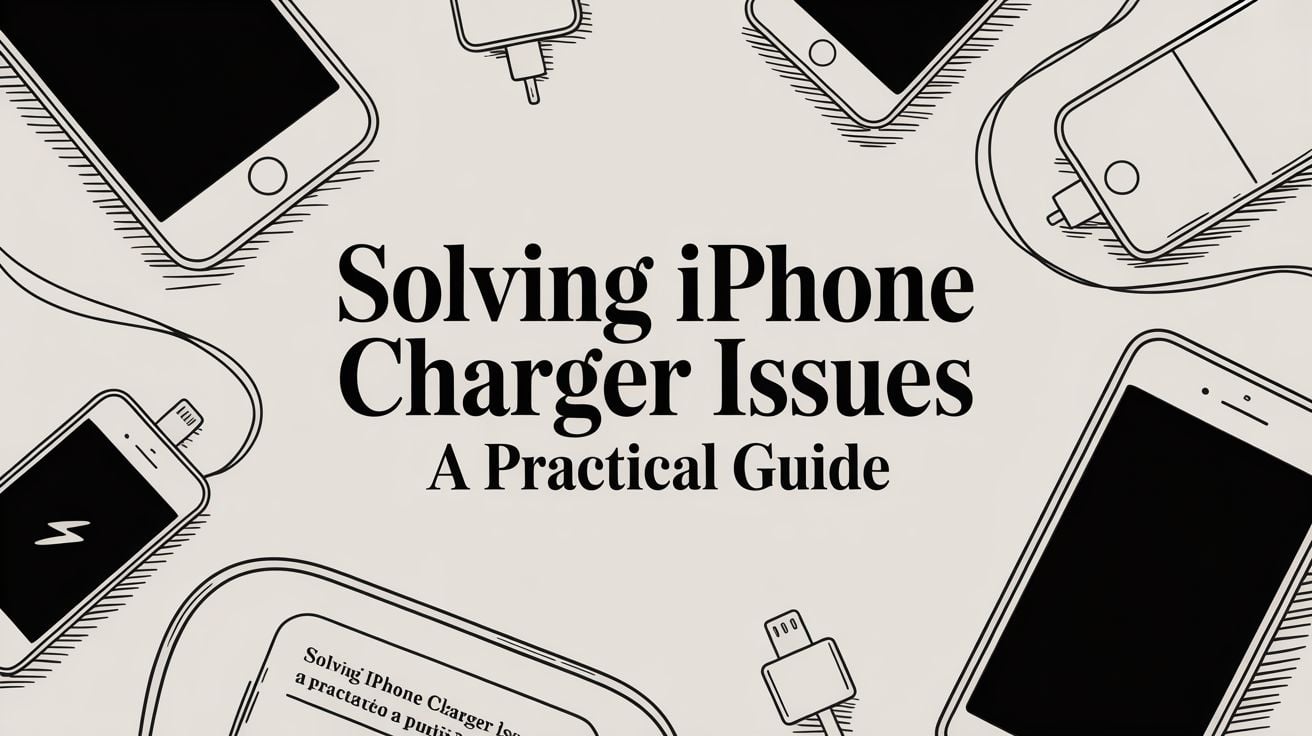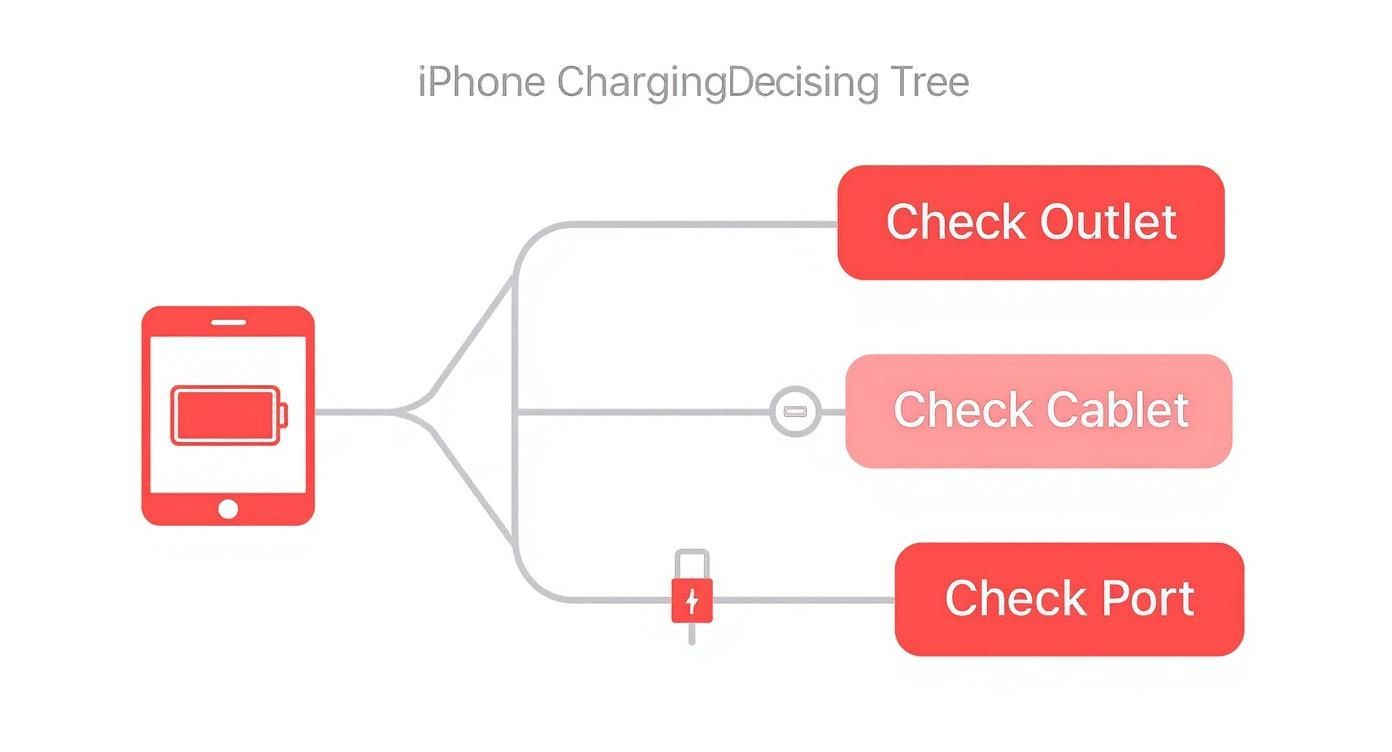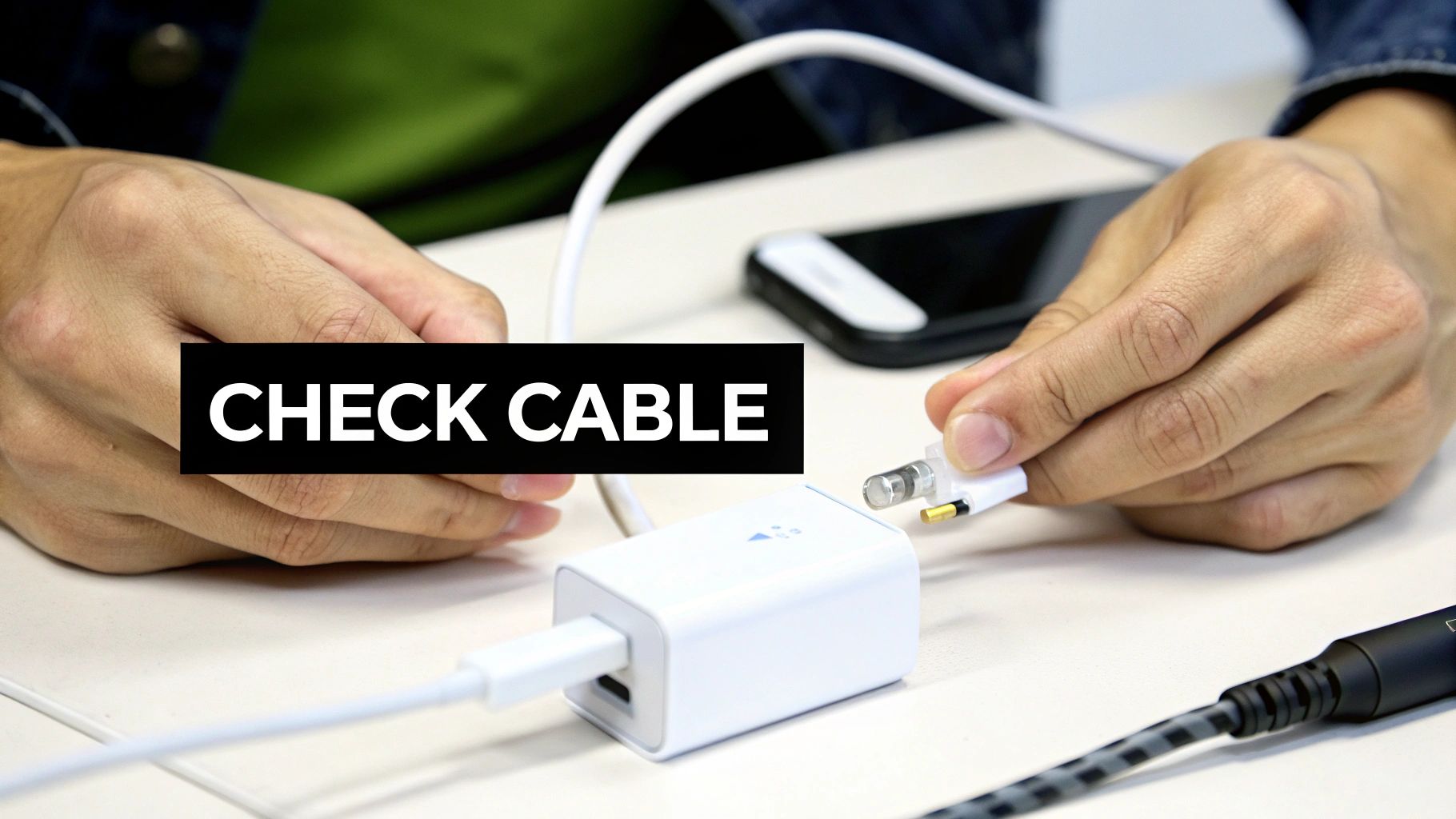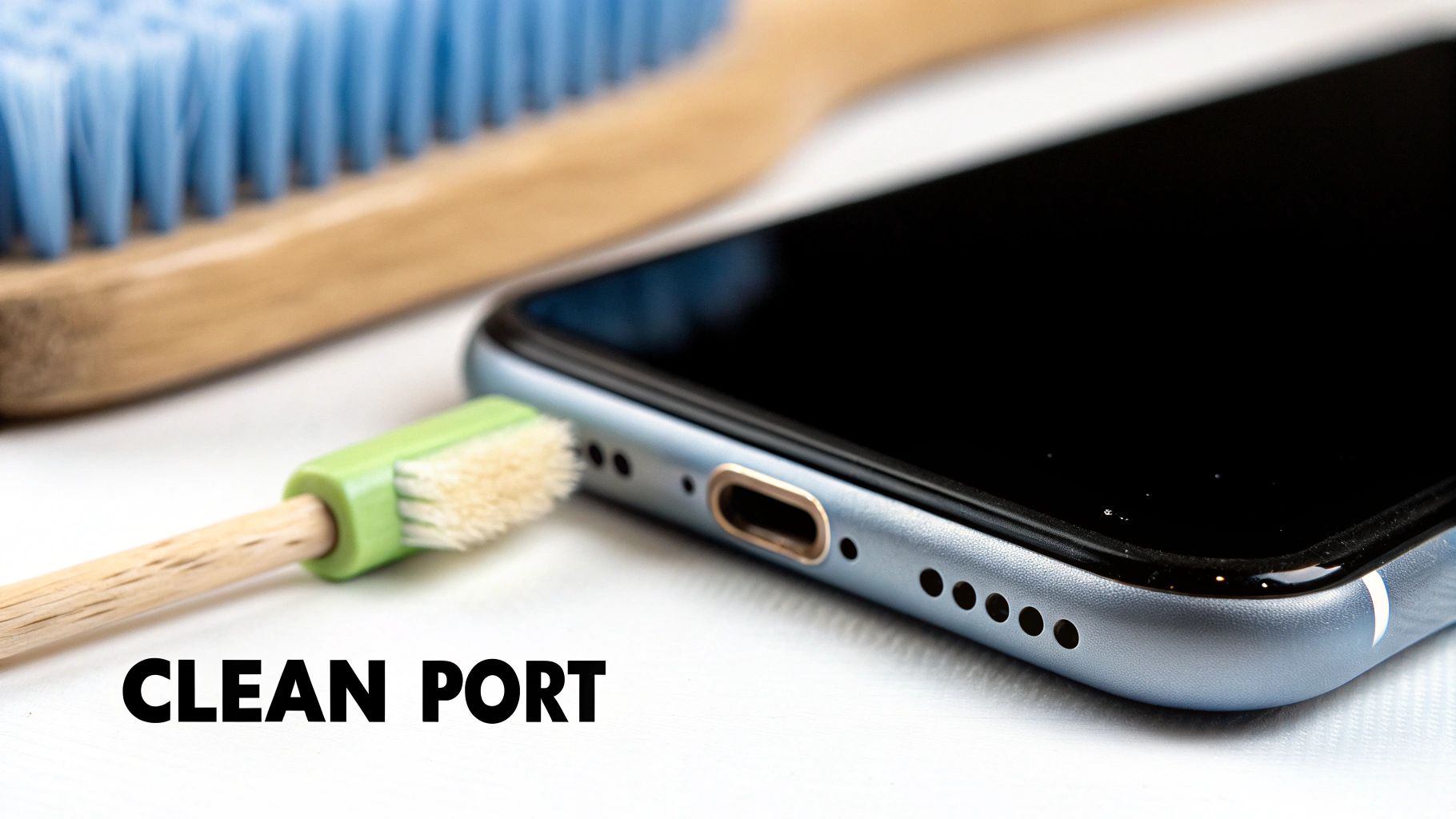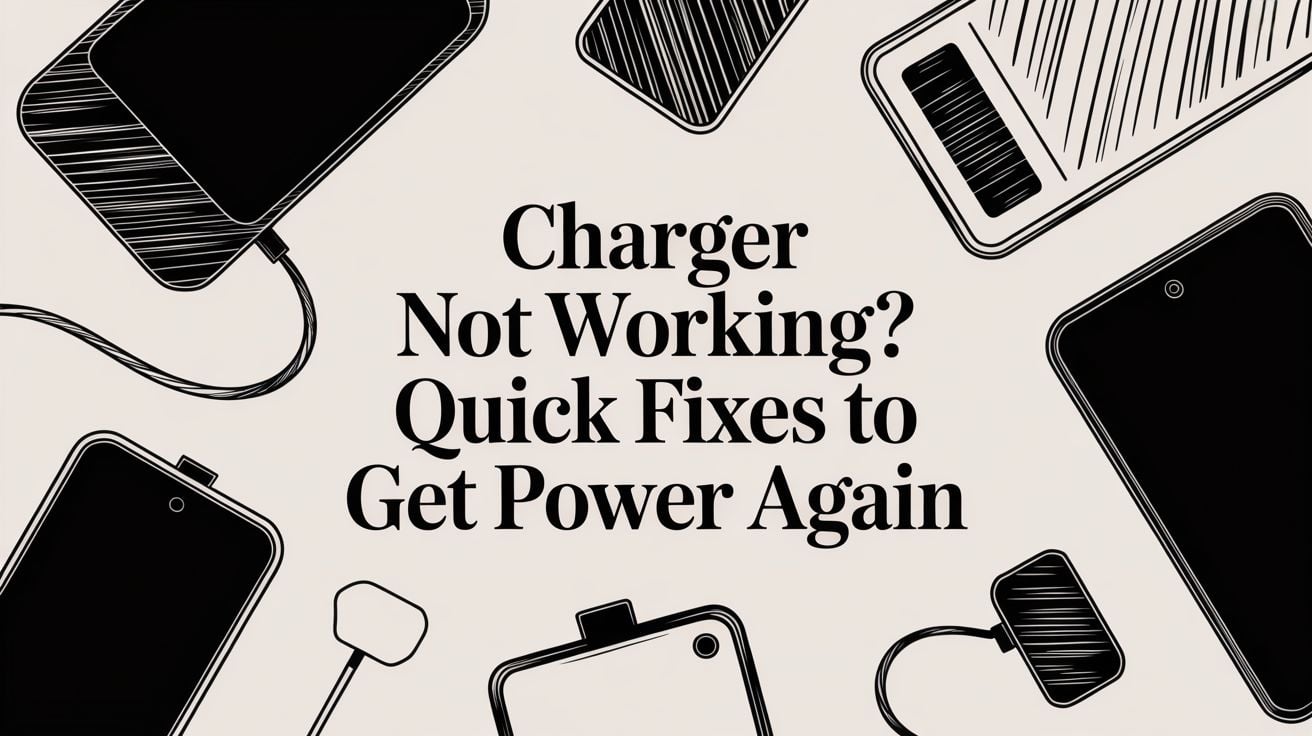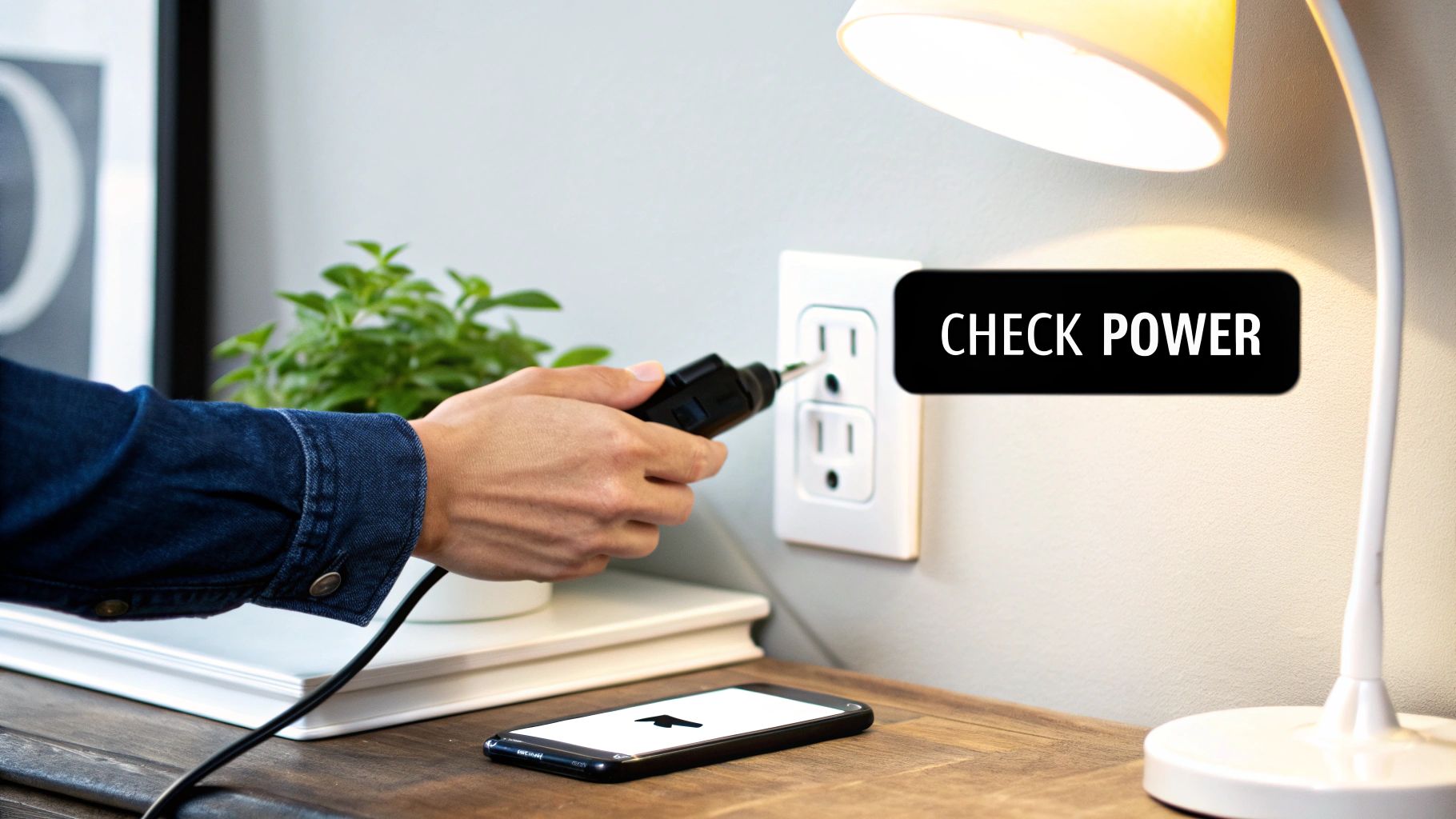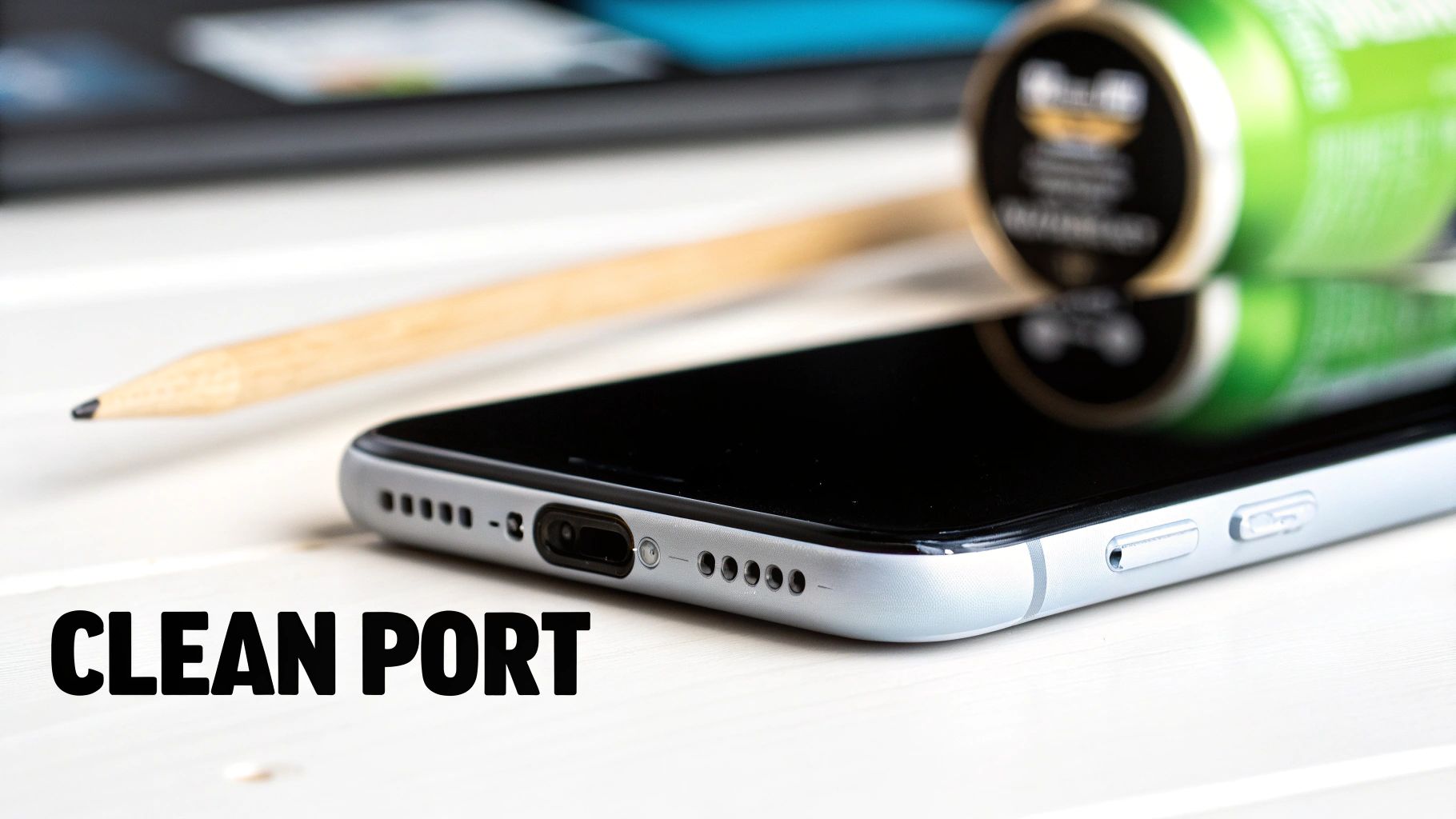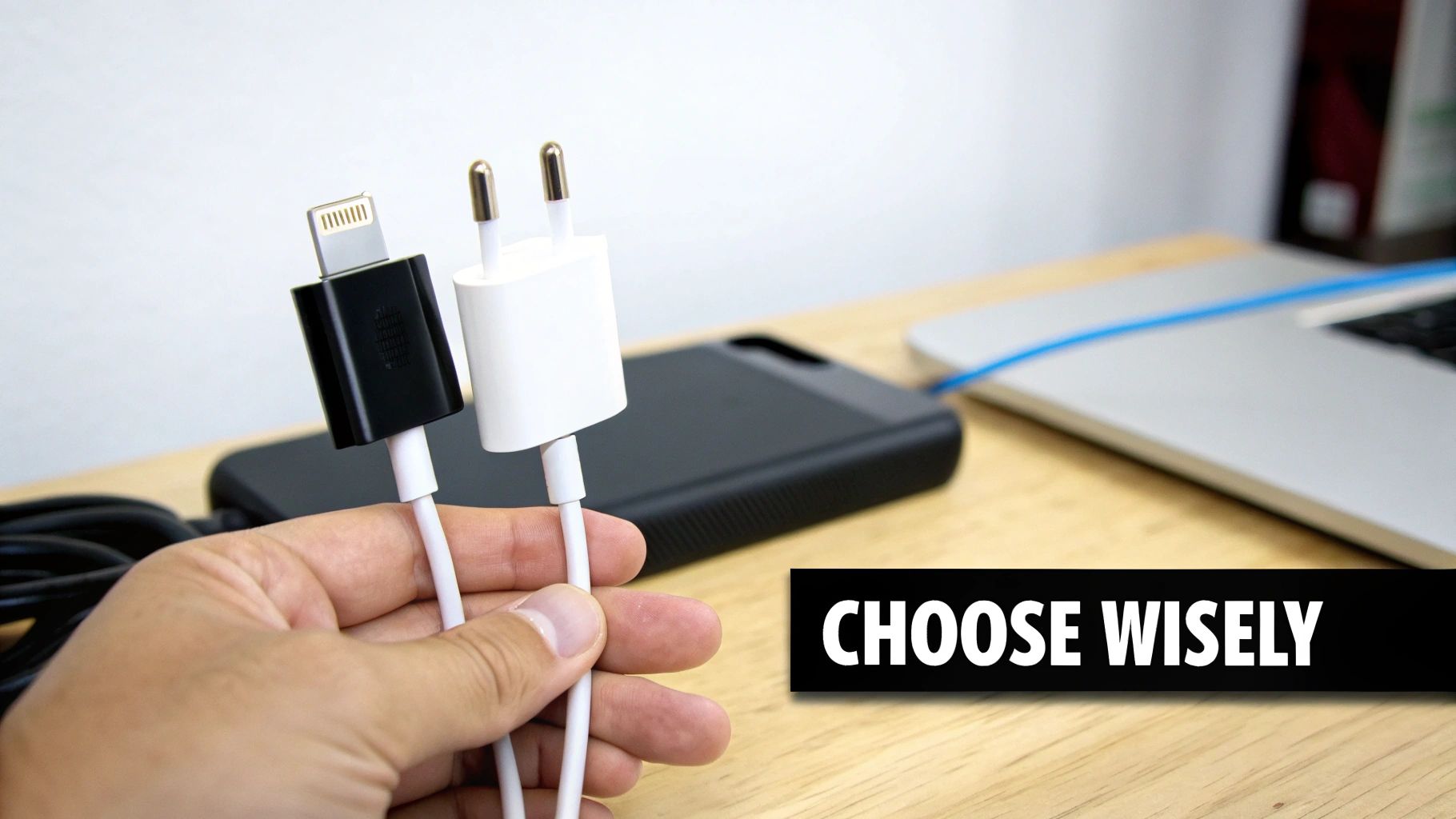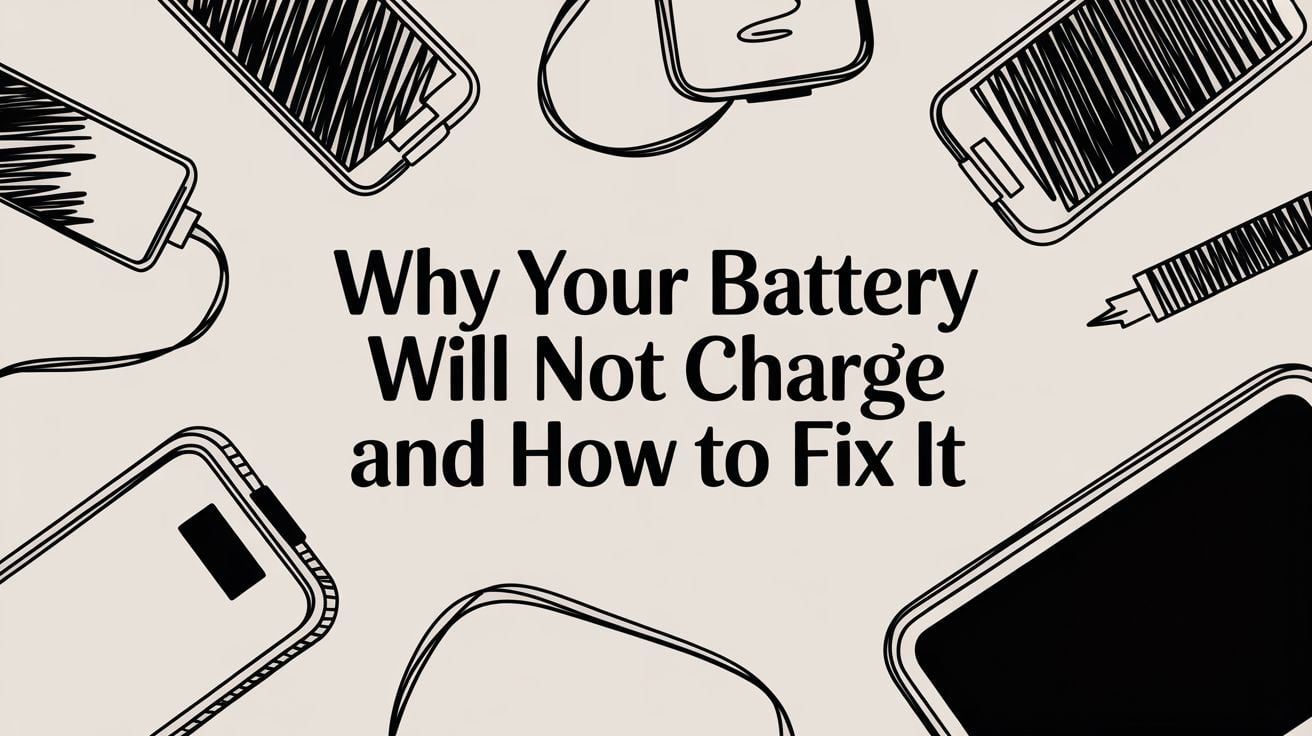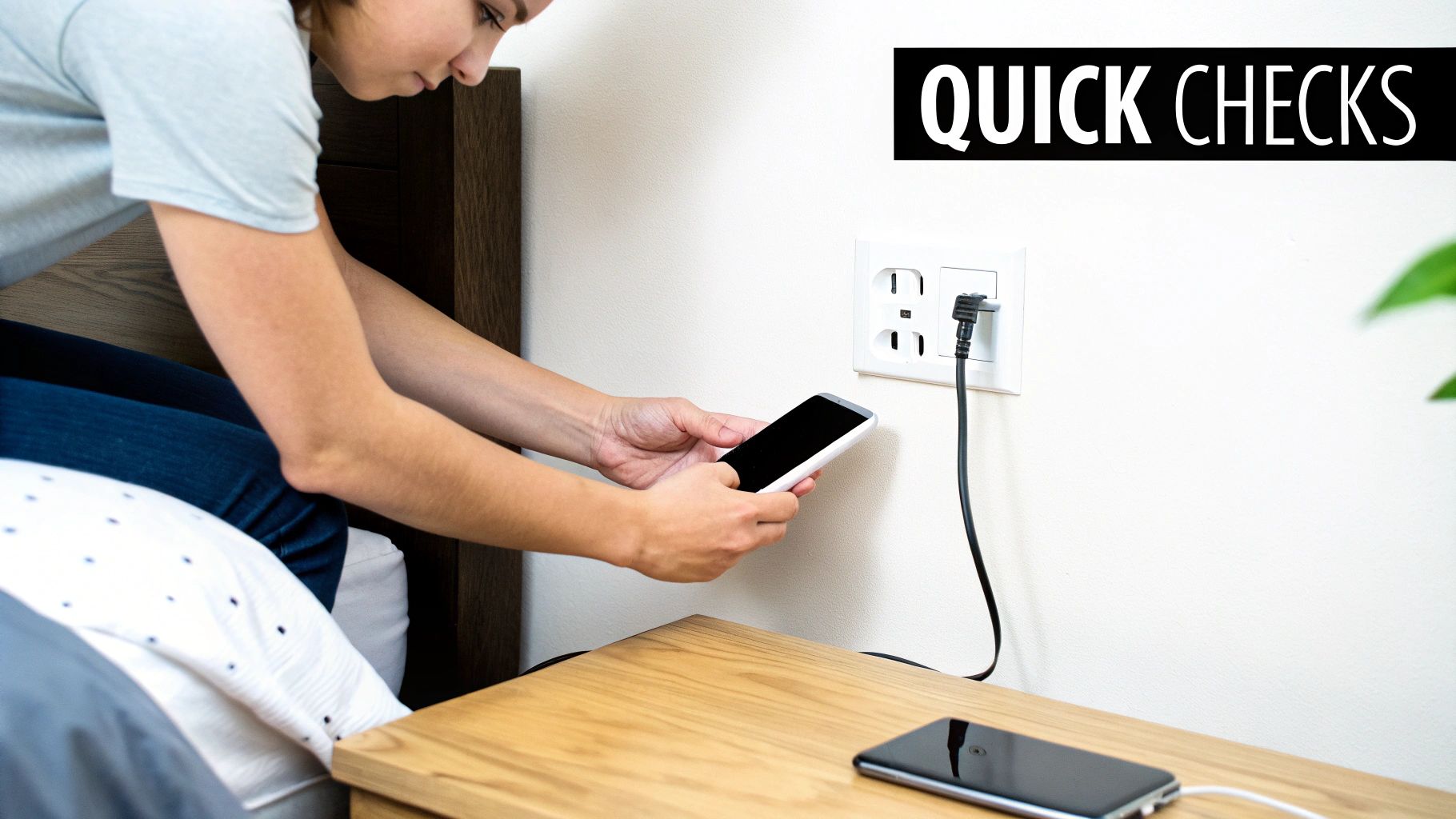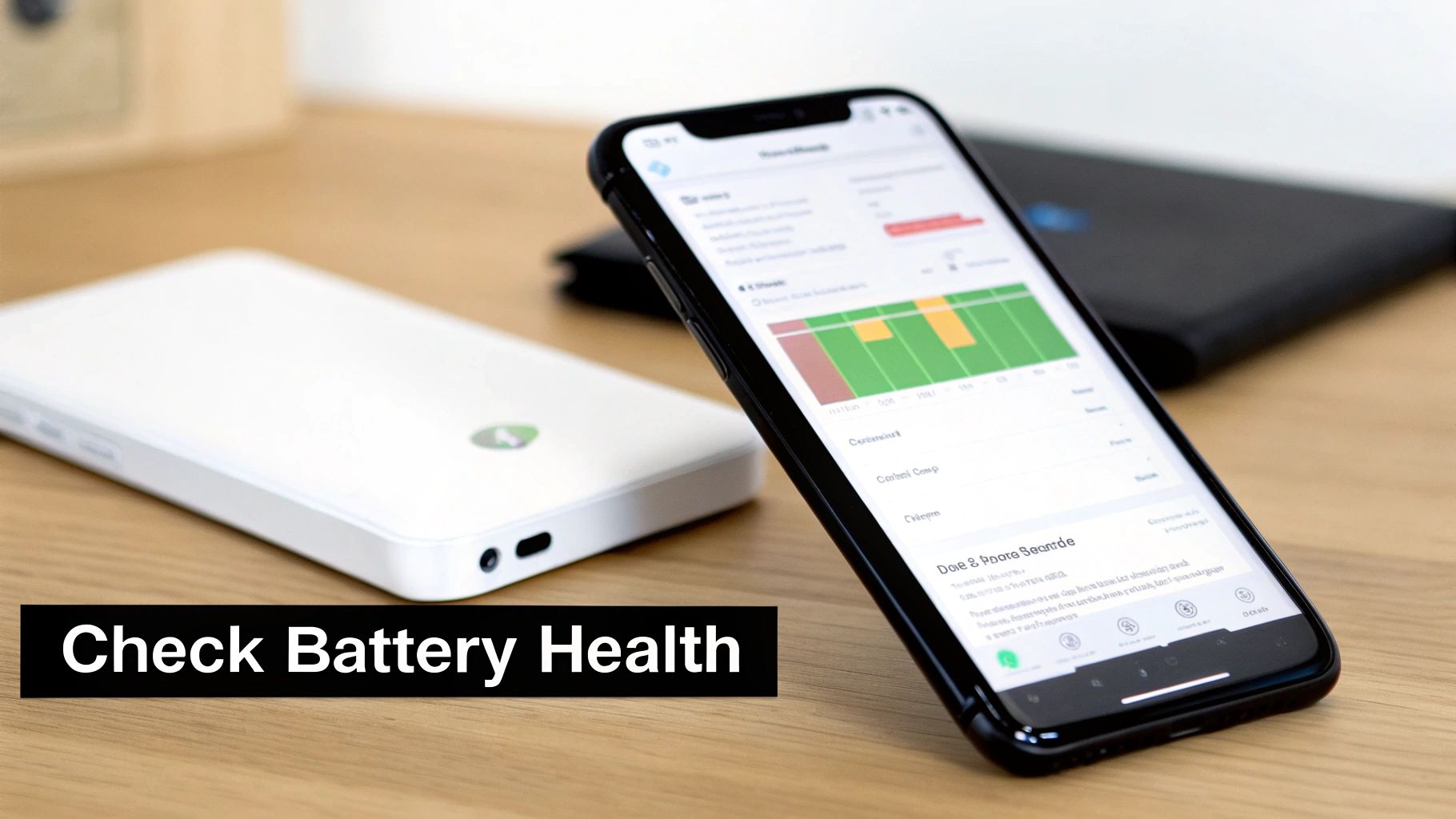amp hour to watt hour: Easy Conversion Guide
To figure out how much energy a battery holds, you just multiply its amp-hours by its voltage. It’s a simple, one-step conversion that shows you the true energy inside, making it the best way to compare different batteries.
Why Amp Hours Don't Tell the Whole Story
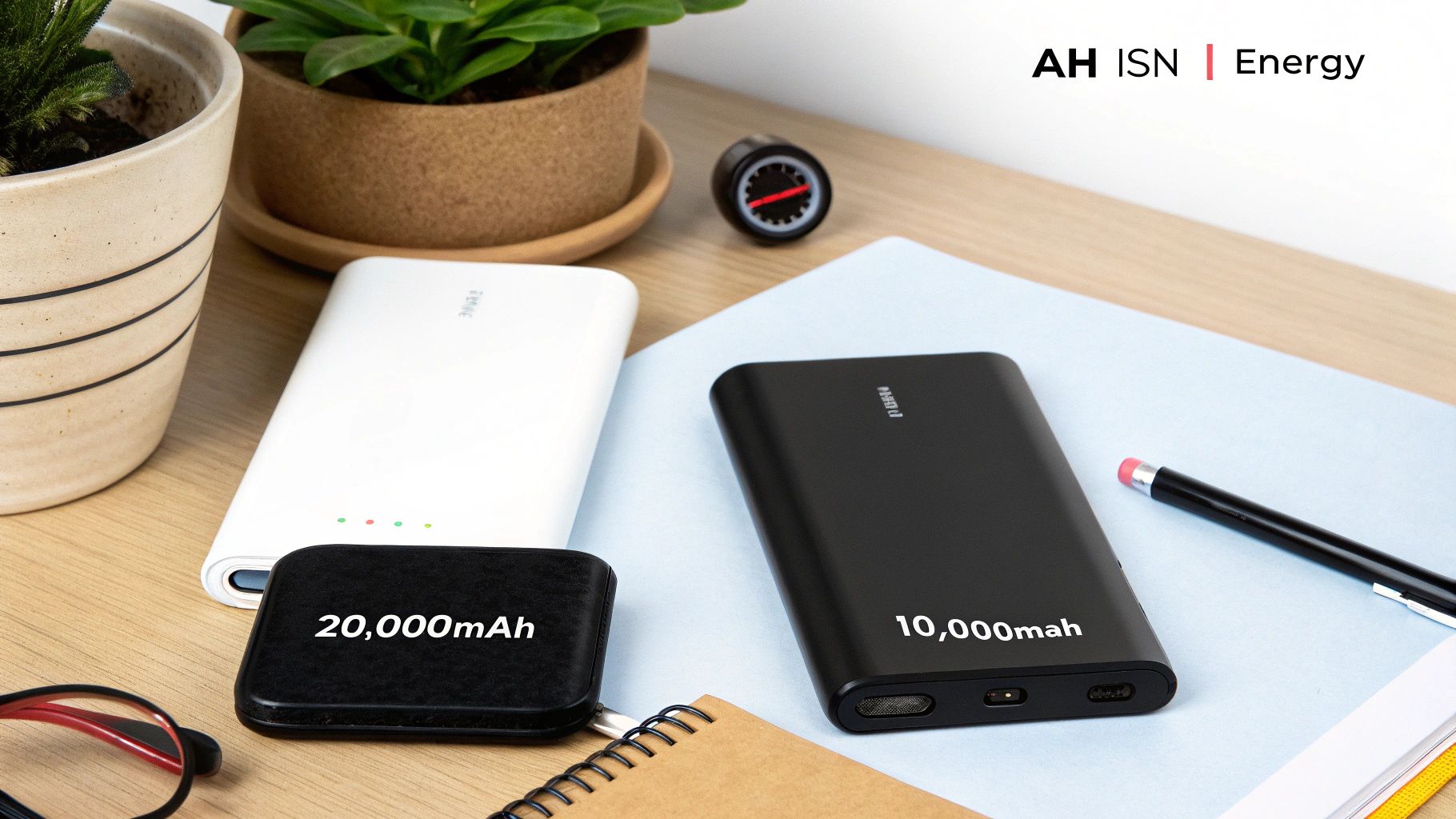
Ever grabbed a 20,000mAh power bank, thinking it must have twice the power of a 10,000mAh model? It seems like simple math, but the truth is that amp-hours (Ah)—or their smaller cousin, milliamp-hours (mAh)—only tell you part of the story.
On its own, this number can be misleading when you're trying to compare different kinds of batteries. Think of amp-hours like the size of a gas tank. A 10-gallon tank is a 10-gallon tank, but how far you can drive depends on the car's engine.
The Missing Piece of the Puzzle
That missing piece in the energy puzzle is voltage (V). Amp-hours tell you about the amount of electricity a battery can hold. But voltage is the pressure or force that pushes that electricity out. To understand the total energy your battery has, you need both.
And that’s where watt-hours (Wh) come in.
Watt-hours represent the true, usable energy stored in a battery. It's the universal language of power capacity that allows for a fair, apples-to-apples comparison between any two batteries, no matter their voltage.
This is why airlines and safety regulators set their battery limits in watt-hours, not amp-hours. A 100Wh limit is a clear, standard measure of total energy. It's a much better indicator of a battery's power than an amp-hour rating by itself. Without voltage, you're only getting half the picture.
Putting It All Together
The connection between amp-hours (Ah) and watt-hours (Wh) is all about the battery's voltage (V). The formula is as simple as it gets: Wh = Ah × V.
For example, a 12V car battery rated at 100Ah holds 1,200Wh of energy (12V × 100Ah). This means it could supply 1,200 watts of power for one hour. This kind of calculation is essential for everything from setting up solar power to figuring out how long your gadgets will last. If you want to dive deeper into these calculations, you can find more insights on how to work backwards from watt-hours to amp-hours here.
By learning this simple conversion, you can:
- Compare Batteries Accurately: Make smarter choices when buying power banks, laptop batteries, or even a power system for an RV.
- Estimate Runtimes: Get a much better idea of how long your devices will last on a single charge.
- Travel Smarter: Quickly check if your batteries meet airline rules without any guesswork.
Ultimately, understanding this helps you see past marketing hype and focus on the one number that truly defines a battery's performance: its total stored energy.
The Simple Formula for Amp-hours to Watt-hours
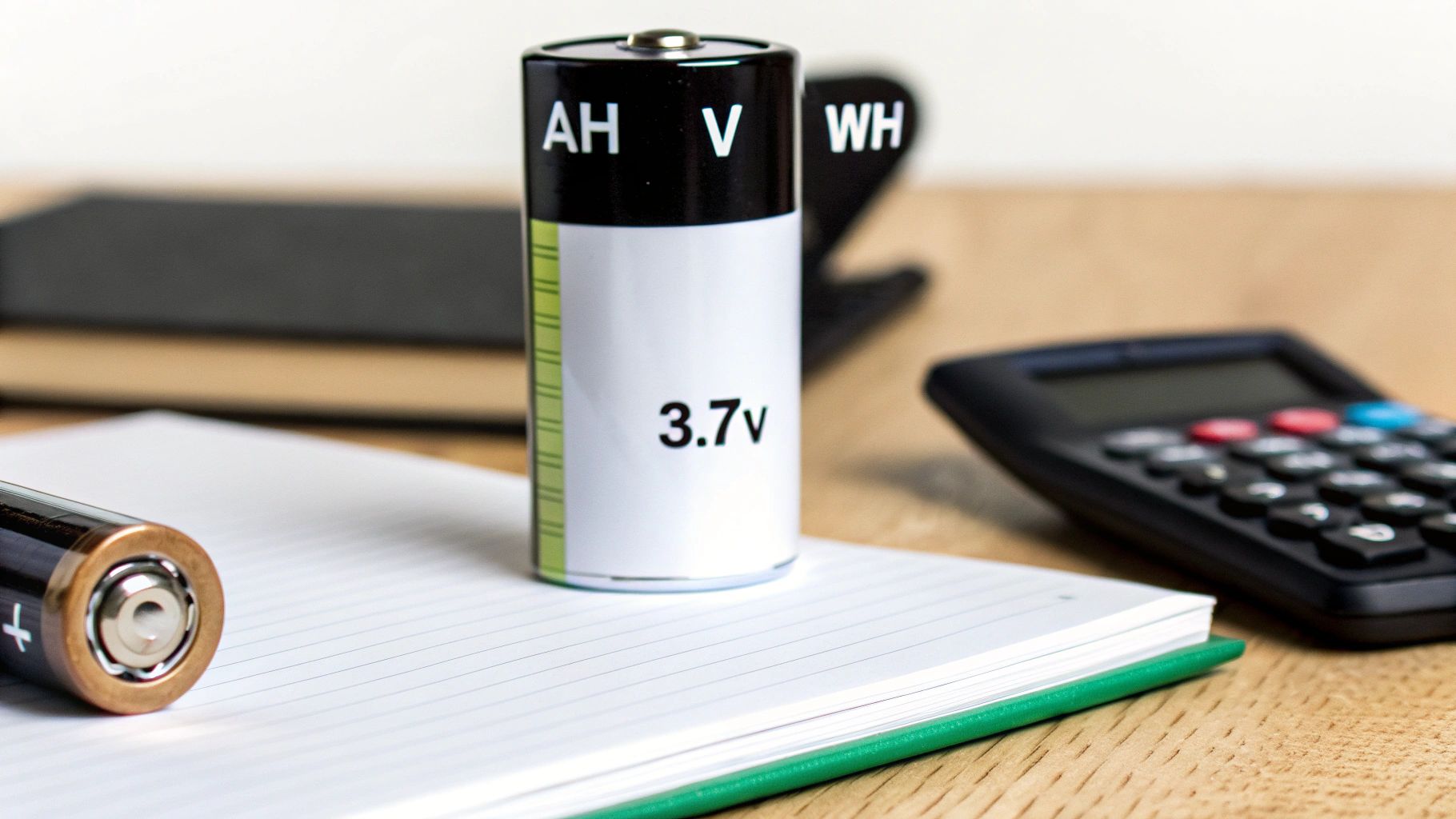
So, how do you actually compare a power bank listed in amp-hours with a laptop battery measured in watt-hours? There's a surprisingly simple way to see which one holds more power, and it just takes a bit of basic multiplication.
The magic happens with this one little equation:
Watt-Hours (Wh) = Amp-Hours (Ah) × Voltage (V)
That’s it. Seriously. Just multiply a battery's amp-hour rating by its voltage, and you get the total energy it can really hold. This is the key to an accurate amp-hour to watt-hour conversion every single time, letting you compare apples to apples.
Making Sense of the Formula
Let's break down what each part actually means. A great way to picture it is to think of electricity like water flowing through a hose.
- Amp-Hours (Ah): This is like the amount of water you have stored in your tank. A 100Ah battery has more "water" (electrical charge) than a 50Ah one.
- Voltage (V): This is the pressure pushing that water out. Higher voltage means more force behind the flow.
- Watt-Hours (Wh): This tells you the total work that water can do. A small tank with super high pressure might empty quickly, while a huge tank with a slow trickle could run for days.
By combining the amount of charge (Ah) with its pressure (V), you get the true measure of a battery's total energy—its watt-hours.
A battery's watt-hour rating is its most honest and universal measure of capacity. It includes both the amount of electricity and the force pushing it, giving you a complete picture of its power.
Where to Find the Voltage
Okay, to use the formula, you need that voltage number. Luckily, it’s almost always printed right on the device. You just have to know where to look.
Check these common spots:
- On the battery label itself: Look for a number followed by a "V," like 12V or 3.7V.
- On the charger or power adapter: The charging brick will list its output voltage.
- In the device’s manual: If you can't find it on the hardware, a quick check of the product manual or the manufacturer's website will give you the technical info.
Once you’ve got the amp-hours and the voltage, you’re all set. You now have everything you need to calculate the true energy capacity of any battery and make much smarter decisions about the gear you rely on every day.
Putting the Amp Hour to Watt Hour Conversion to Work
Okay, theory is one thing, but let's look at some real-world examples. The best way to understand this is to look at the gadgets you use every day. This isn't just about memorizing a formula; it's about seeing how it works in real life.
Your Smartphone Battery
Let’s start with the device that’s probably in your pocket right now. A typical modern smartphone has a battery with around 5,000mAh capacity, which is just another way of saying 5Ah.
The battery cells inside your phone operate at a voltage of about 3.7V. Now we can plug those numbers into our formula:
- The Math: 5Ah × 3.7V = 18.5Wh
So, your phone's battery stores 18.5 watt-hours of energy. This little piece of information is very useful, especially when you're trying to figure out how many times a power bank can actually charge your phone.
The Everyday USB Power Bank
Power banks are a perfect example of where amp-hours can be a bit misleading. You see a massive 20,000mAh number on the box, but just like your phone, its internal battery cells are usually running at 3.7V.
- The Math: 20,000mAh (or 20Ah) × 3.7V = 74Wh
Here's the catch: the USB ports on that power bank don't deliver power at 3.7V; they deliver it at 5V. This voltage difference is why you can't just divide the power bank's mAh by your phone's mAh to get an accurate recharge count. When you understand the watt-hours of both devices, the picture becomes much clearer. And if you really want to make your portable charger last longer, it pays to know how to use a power bank effectively.
By converting to watt-hours, you can compare any two batteries—a tiny earbud case and a massive power bank—on a truly level playing field. It cuts through the marketing fluff and reveals the actual energy stored inside.
Laptops and Higher Voltage Systems
Laptops add another layer because their batteries operate at much higher voltages. A modern laptop might have a battery rated at 5,000mAh (5Ah)—the same as our phone example—but it could be running at 15.4V.
- The Math: 5Ah × 15.4V = 77Wh
See that? Even with the same amp-hour rating, the laptop battery holds more than four times the energy of the smartphone battery. This is a perfect example of why voltage is the crucial, often-overlooked part of the energy equation.
A Quick Reference Guide
To make this even easier, here’s a quick-glance table for some common devices. It’s a handy cheat sheet for seeing how these conversions work in practice.
| Device Type | Typical Voltage (V) | Example Amp-Hours (Ah) | Calculated Watt-Hours (Wh) |
|---|---|---|---|
| Smartphone Battery | 3.7V | 5Ah (5,000mAh) | 18.5Wh |
| USB Power Bank (Internal) | 3.7V | 20Ah (20,000mAh) | 74Wh |
| Laptop Battery | 11.1V – 15.4V | 5Ah (5,000mAh) | 55.5Wh – 77Wh |
| 12V RV/Marine Battery | 12V | 100Ah | 1,200Wh (1.2kWh) |
| Small Drone Battery | 7.4V | 2Ah (2,000mAh) | 14.8Wh |
As you can see, the same Ah value can result in very different Wh numbers once you include the voltage. It’s all about the total energy.
The Versatile 12V Battery
Finally, let's talk about the workhorse of the DIY and off-grid world: the standard 12V battery. You’ll find these in RVs, boats, and solar power setups. A very common size is the 100Ah battery.
- The Math: 100Ah × 12V = 1,200Wh or 1.2kWh
This calculation is absolutely essential for anyone planning their own power system. When you're designing a setup to run your life off-grid, getting the energy math right is critical, as you can see in this awesome off-grid shipping container modular home project. It tells you exactly how much energy you have stored to run your lights, fridge, and electronics.
Why This Simple Conversion Is So Important
So, you've got the hang of the amp-hour to watt-hour conversion. This isn't just a neat trick for tech fans; it's genuinely useful knowledge that changes how you buy, use, and travel with your electronics.
This simple math gives you real-world understanding, turning the numbers on a label into something you can actually use. Let's break down how this helps.
See Through the Marketing Hype
Battery makers love using big numbers. Let's be honest, "20,000mAh" just sounds way more impressive than "74Wh," right? It's a classic marketing move.
Because most power banks use low-voltage cells (typically 3.7V), they can advertise a huge mAh figure that doesn't really tell you how it'll perform with higher-voltage devices like your laptop.
By converting everything to watt-hours, you get a universal standard. Suddenly, a 74Wh power bank and a 77Wh laptop battery are easy to compare. You can see at a glance that they hold a very similar amount of total energy, cutting right through the noise of different voltages and misleading mAh ratings.
Understanding watt-hours is your best defense against confusing marketing. It lets you make a true apples-to-apples comparison of energy capacity, ensuring you get the power you actually paid for.
Accurately Estimate How Long Your Gear Will Last
Ever wonder why your 100Ah battery doesn't run a 1-amp device for exactly 100 hours? It all comes down to the device's power usage, which is measured in watts.
Once you know the watt-hour capacity of your battery, you can calculate realistic runtimes. For instance, if you have a 1,200Wh battery and need to power a light that uses 100 watts, you can expect it to last about 12 hours (1,200Wh / 100W).
This is incredibly valuable for planning. Whether you're a camper figuring out how long your portable fridge will run or a remote worker trying to get more time out of a laptop, watt-hours provide the clarity you need. If you're curious how this applies to bigger devices, you can learn more about how many watts it takes to charge a laptop in our detailed guide.
This chart really puts it into perspective, showing how watt-hours provide a clear measure of energy across different batteries.

It's easy to see that while a power bank has much more juice than a phone, an RV battery is in a completely different league.
Travel Safely and Without Hassle
This might be the most critical reason of all. Airline rules for carrying batteries are almost always based on watt-hours. The Federal Aviation Administration (FAA) and other international groups set strict limits—typically around 100Wh per battery—to keep flights safe.
If you show up at airport security with a massive power bank labeled only in mAh, you might have a problem.
But if you’ve already done the simple math—Ah × V = Wh—you'll know instantly whether your gear is okay to fly. Being able to confidently show a security agent that your 20,000mAh (74Wh) power bank is well under the 100Wh limit can save you a world of hassle and ensure your essential power source makes the trip with you.
What Affects Real-World Battery Performance

While our amp hour to watt hour formula gives you a solid starting point, the real world is a bit different. That watt-hour number on the label represents the battery's potential under perfect lab conditions. But once that battery is in your phone, your power bank, or your camper, things change.
Think of it like the official mileage sticker on a new car. It gives you a specific MPG rating, but your actual mileage will always depend on how you drive and the weather. Batteries work the same way; their performance isn't a fixed number.
Knowing these factors isn't about making things complicated. It’s about setting realistic expectations for how your devices will actually perform day-to-day.
Voltage Isn't Always Constant
The simple conversion formula, Wh = Ah × V, assumes that voltage is a steady number. In reality, a battery's voltage isn't a flat line—it gradually drops as the battery is used. A fully charged phone battery might start at 4.2V but can fall to 3.0V or even lower by the time it's empty.
This natural voltage drop means the actual energy you get can be a bit different from the official rating. For example, a 24V battery rated at 100Ah is listed as 2,400Wh, but the real-world output will change because of this voltage drop.
Your battery's voltage is more like a slow, steady decline than a flat line. This natural drop during use is one of the main reasons the calculated watt-hours and the real-world performance don't always match perfectly.
External Factors That Drain Your Power
Besides voltage, several other things can affect your battery’s true output. Keep these in mind, and you'll get a much better sense of how to get the most out of every charge.
Three major factors are always at work:
- Extreme Temperatures: Heat and cold are enemies of batteries. Freezing weather can temporarily reduce a battery's capacity by 20% or more, while too much heat speeds up permanent damage.
- How Fast You Use Power: Pulling a lot of power out quickly is less efficient than a slow, steady drain. Running a high-power appliance like a microwave will use up your battery's energy faster than using the same amount of energy to power an LED light over a longer time.
- Battery Age and Health: Like all things, batteries wear out. Every charge and discharge cycle slowly reduces a battery's ability to hold a full charge.
Managing these factors, especially temperature and your charging habits, is key. You can learn more about the impact of temperature and charging rates on lithium-ion cells in our detailed guide. This is exactly why we built Chargie—to manage these very issues, helping your battery last longer by preventing the stress that makes it age faster.
Putting It All Together: Your Battery Capacity Questions Answered
Even with the formula in hand, it's normal for a few questions to pop up. Getting a real feel for how amp-hours, watt-hours, and voltage all work together takes a bit of practice.
Let's look at some of the most common questions people ask. These practical points can help make the concepts clearer.
Can I Convert Watt Hours Back to Amp Hours?
You absolutely can. The math works just as well in reverse. You just need to flip the formula around:
Amp-Hours = Watt-Hours ÷ Voltage (Ah = Wh / V)
This is incredibly handy. Imagine you're setting up a solar power system and figure out you need 2,000Wh of energy per day. If you're building it around a 12V battery system, you now know what to look for: 2,000Wh ÷ 12V = 166.7Ah. You'd probably buy a 200Ah battery to have a bit of a safety cushion.
For anyone planning a bigger project like this, understanding solar battery backup costs is a huge part of the equation, and it all starts with getting this capacity calculation right.
Why Do Power Banks Advertise mAh Instead of Wh?
Honestly, it's mostly a marketing gimmick. A huge number like 20,000mAh just sounds more powerful to the average person than its actual energy rating of 74Wh.
Manufacturers get that giant mAh number by using the low 3.7V of the small battery cells inside the power bank. While it's technically correct for those internal cells, it's not a true measure of the power bank's usable energy, especially since it has to increase the voltage to charge your 5V phone.
This is exactly why watt-hours (Wh) is the gold standard. It's the only truly universal way to measure a battery's total stored energy. It's no accident that safety regulators and airlines rely on it.
Does This Conversion Work for Car Batteries Too?
Yes, it works for everything. The relationship Wh = Ah × V is a basic principle of electricity. It doesn't matter what kind of battery you're looking at.
This formula applies to:
- Standard lead-acid car batteries
- The lithium-ion batteries in your phone and power banks
- Large Lithium Iron Phosphate (LiFePO4) batteries used in RVs
- Even your rechargeable AA batteries
The only thing that changes is the voltage you use in the formula. For a typical car battery, that's 12V. For a big truck, it might be a 24V system. As long as you use the correct voltage for the battery you have, the math will always give you the correct watt-hour capacity.
Here at Chargie, we believe understanding your battery is the first step to making it last. By intelligently managing your charging cycles and keeping your battery from sitting at 100% for hours on end, our smart charging device can dramatically extend the life of your phones and laptops. This saves you money, reduces e-waste, and gives you a better experience. Find out how to get more out of your devices at https://chargie.org.



